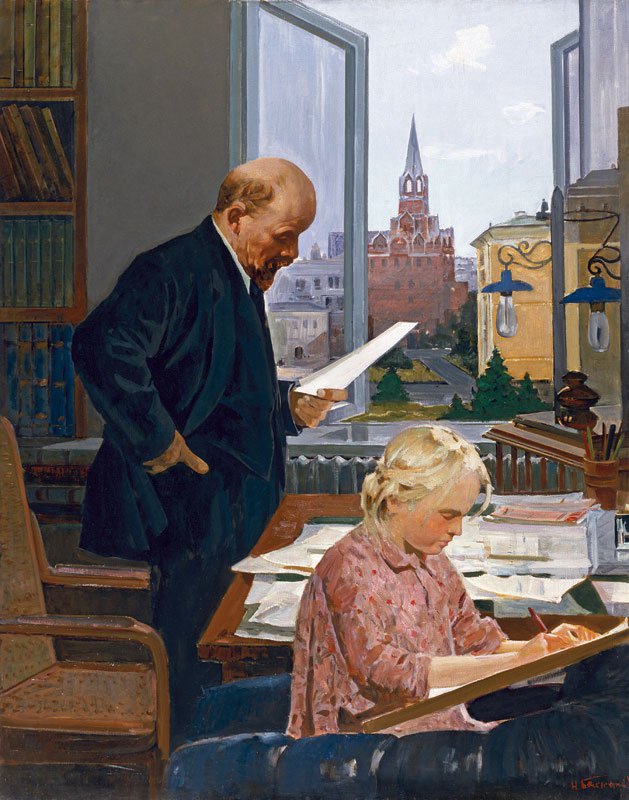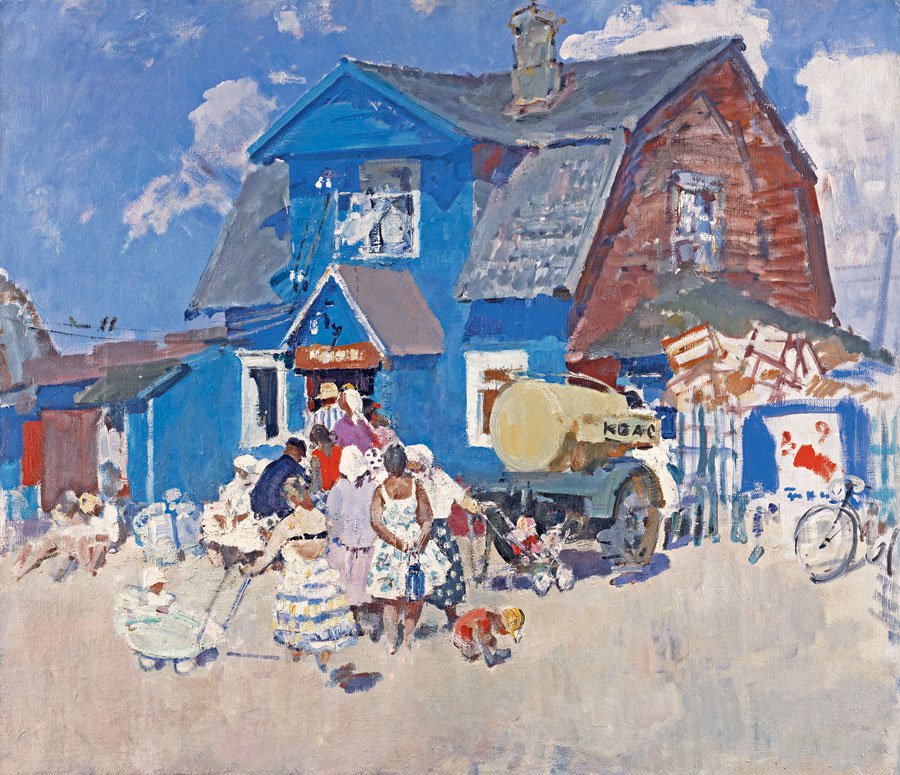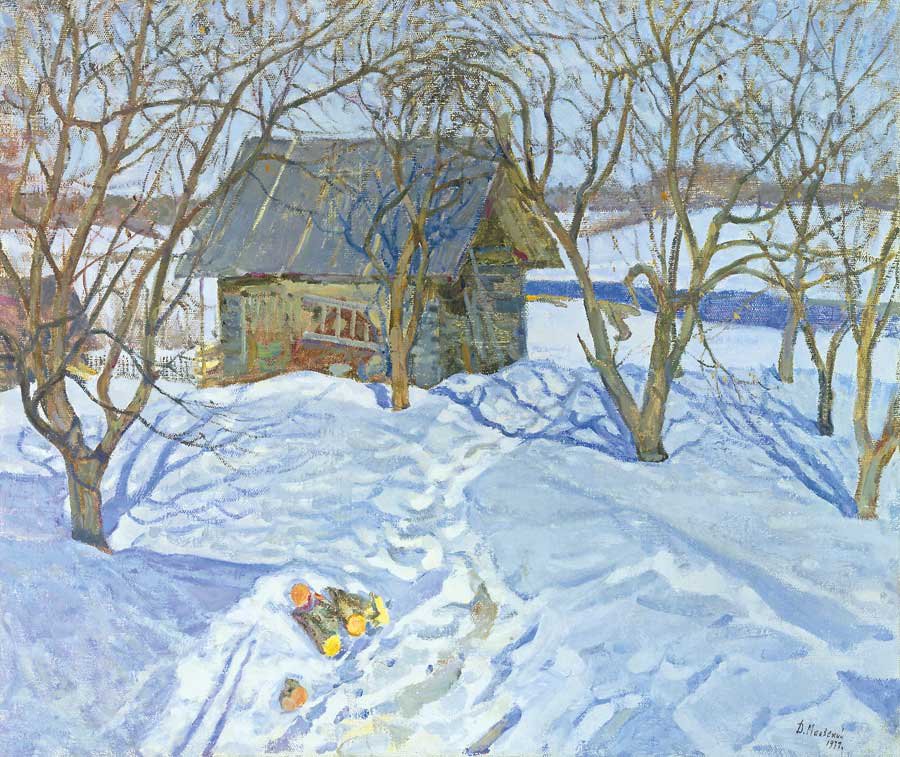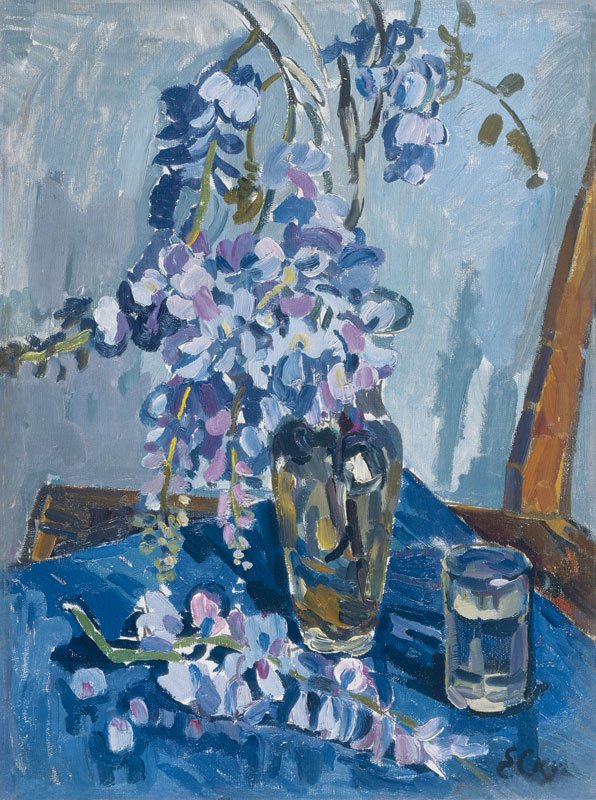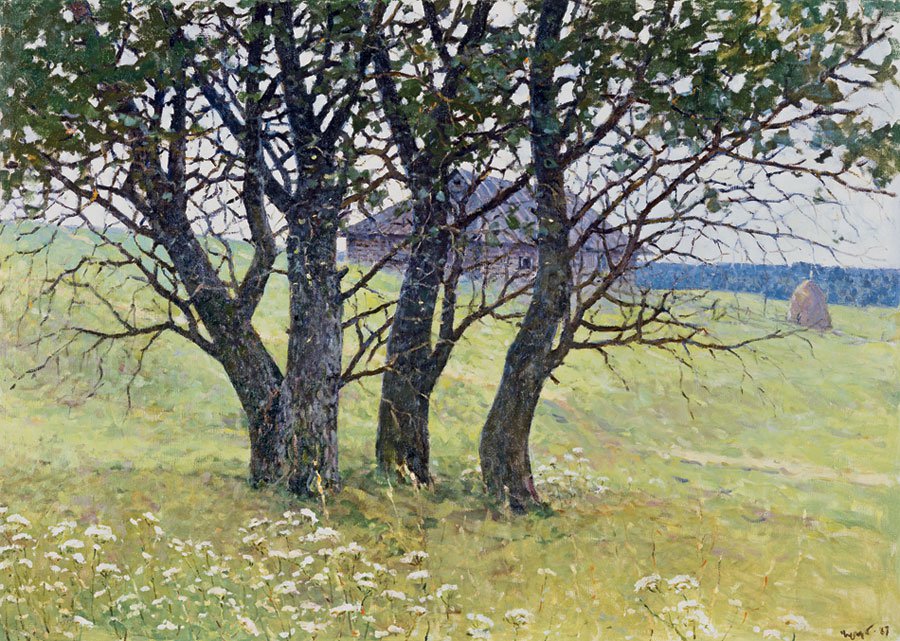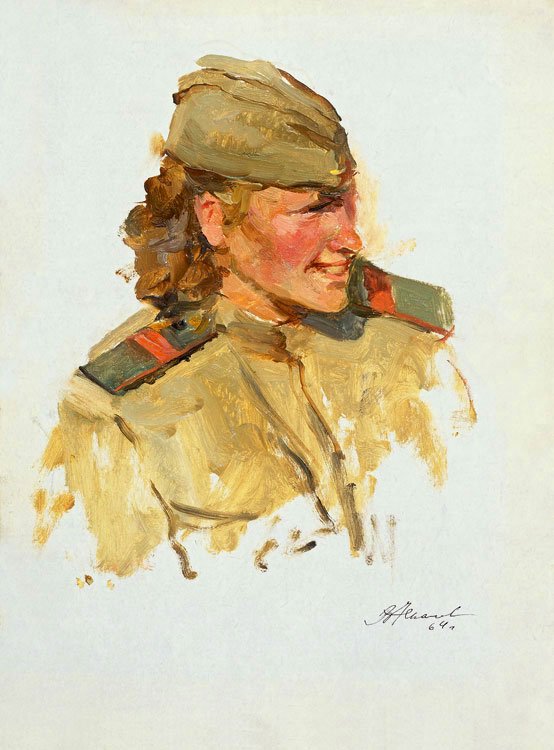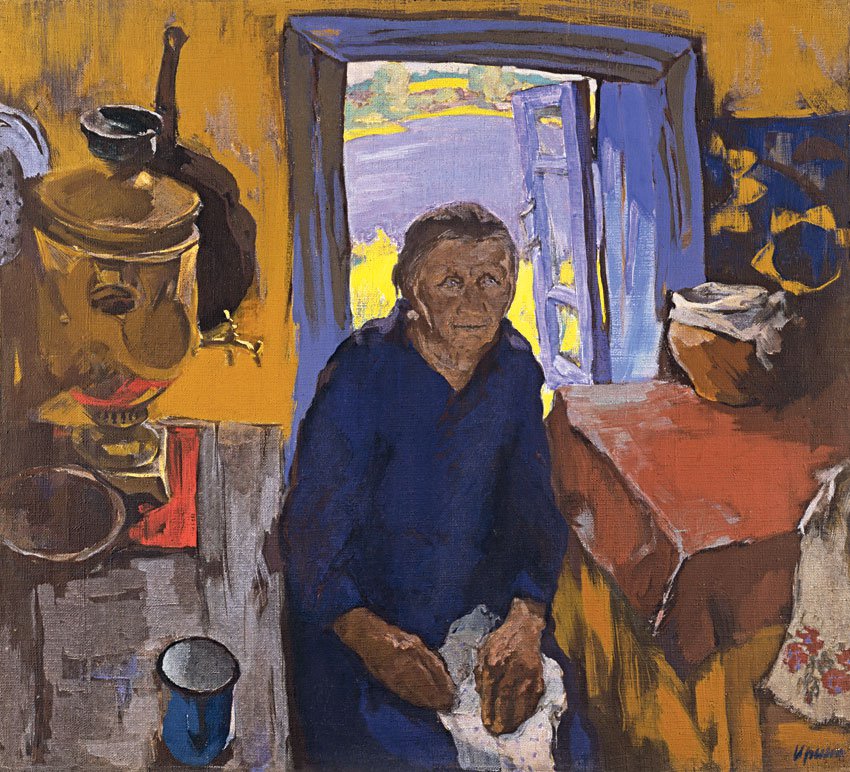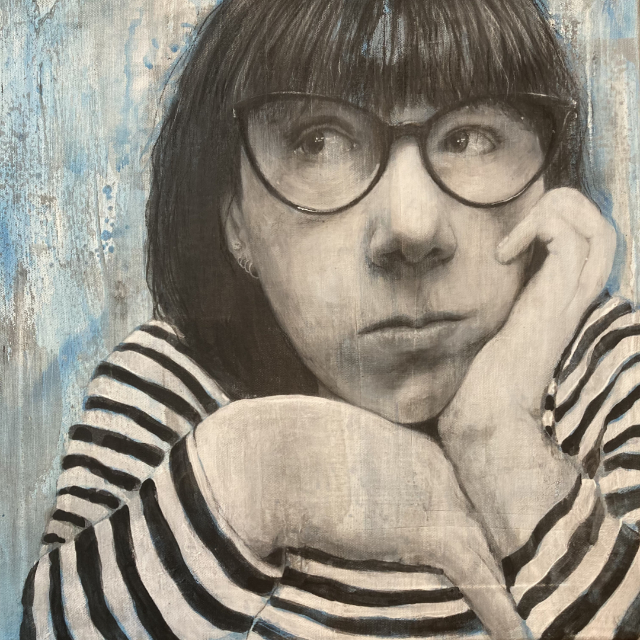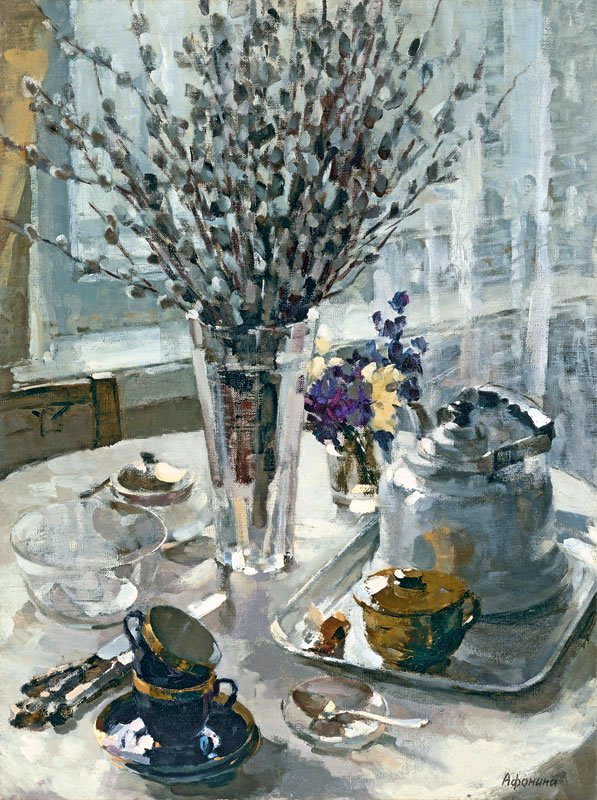 |
||
Taisia Afonina (1913-1994). Still life with Pussy-Willows
Publications:
* Sergei V. Ivanov. Unknown Socialist Realism. The Leningrad School. Saint Petersburg, NP-Print Edition, 2007, plate 43.
* Каталог весенней выставки произведений ленинградских художников 1965 года. Л., Художник РСФСР, 1970. С.7.
* Ленинградские художники. Живопись 1950—1980 годов. Каталог. СПб, 1994. С.3.
* Этюд в творчестве ленинградских художников. Выставка произведений. Каталог. СПб, 1994. С.3.
* Лирика в произведениях художников военного поколения. Выставка произведений. Каталог. СПб, 1995. С.3.
* Живопись 1940—1990 годов. Ленинградская школа. Выставка произведений. СПб, 1996. С.3.
* Иванов С. Тихая жизнь за ленинградским столом // Петербургские искусствоведческие тетради. Выпуск 23. СПб, 2012. С.90-97.
* Афонина Т. Натюрморт с вербой // 80 лет Санкт-Петербургскому Союзу художников. Юбилейная выставка. СПб, Цветпринт, 2012. С.203.
Provenance:
Private collection. Acquired from artist
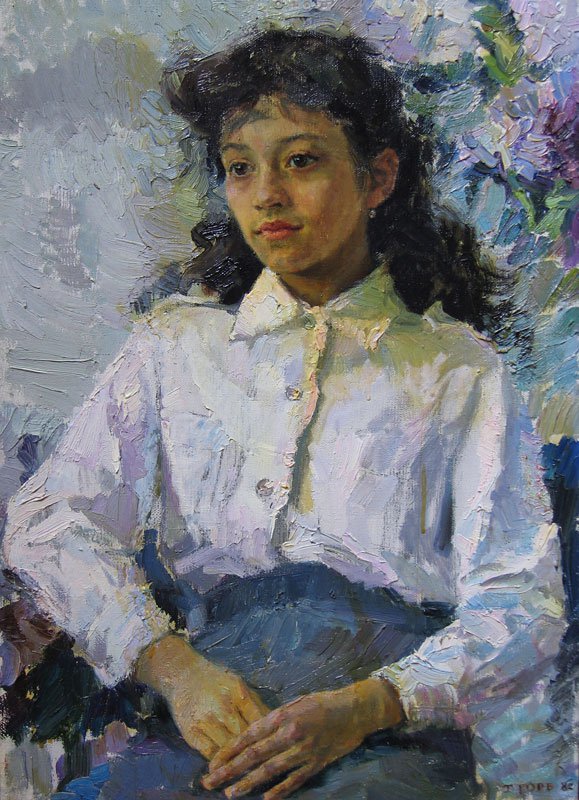 |
||
Tatiana Gorb (1935-2013). Schoolgirl
Publications:
* Sergei V. Ivanov. Unknown Socialist Realism. The Leningrad School. Saint Petersburg, NP-Print Edition, 2007, plate 189.
Provenance:
Private collection. Acquired from artist
 |
||
Nikolai Baskakov (1918-1993). Lenin in Kremlin.
Publications:
* Sergei V. Ivanov. Unknown Socialist Realism. The Leningrad School. Saint Petersburg, NP-Print Edition, 2007, plate 29.
* Nikolai Baskakov. Lenin in Kremlin // 80 years of the Saint Petersburg Union of Artists. The Anniversary Exhibition. Saint Petersburg, 2012. P.203.
* Иванов, С. В. Баскаков Николай Николаевич //Страницы памяти. Справочно-биографический сборник. 1941-1945. Художники Санкт-Петербургского (Ленинградского) Союза художников — ветераны Великой Отечественной войны. Кн.1. СПб: Петрополис, 2014. С.90-92.
Provenance:
Private collection. Acquired from the art gallery.
For more details about artist Biography, Career, and Artistic Creativity, as well as Bibliography please see Wikipedia:
https://en.wikipedia.org/wiki/Nikolai_Baskakov
https://en.wikipedia.org/wiki/Lenin_in_Kremlin_%28painting%29
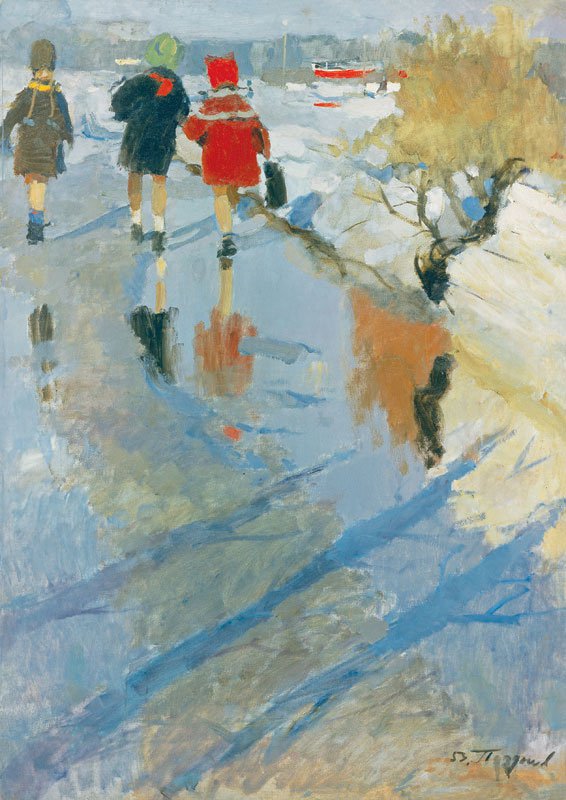 |
||
Nikolai Pozdneev (1930-1978). Spring Day.
Publications:
* Sergei V. Ivanov. Unknown Socialist Realism. The Leningrad School. Saint Petersburg, NP-Print Edition, 2007, plate 182.
* Ленинградские художники. Живопись 1950—1980 годов. Каталог. СПб, 1994. С.6.
* Лирика в произведениях художников военного поколения. Выставка произведений. Каталог. СПб, 1995. С.6.
* Живопись 1940—1990 годов. Ленинградская школа. Выставка произведений. СПб, 1996. С.5.
* Иванов С. О творчестве и судьбе Николая Позднеева // Петербургские искусствоведческие тетради. Вып. 30. СПб, 2014. С.25-32.
Provenance:
Private collection. Acquired from the artist's family
More detail info about artist Biography, Career, and Artistic Creativity, as well as Bibliography please see on Wikipedia:
https://en.wikipedia.org/wiki/Nikolai_Pozdneev
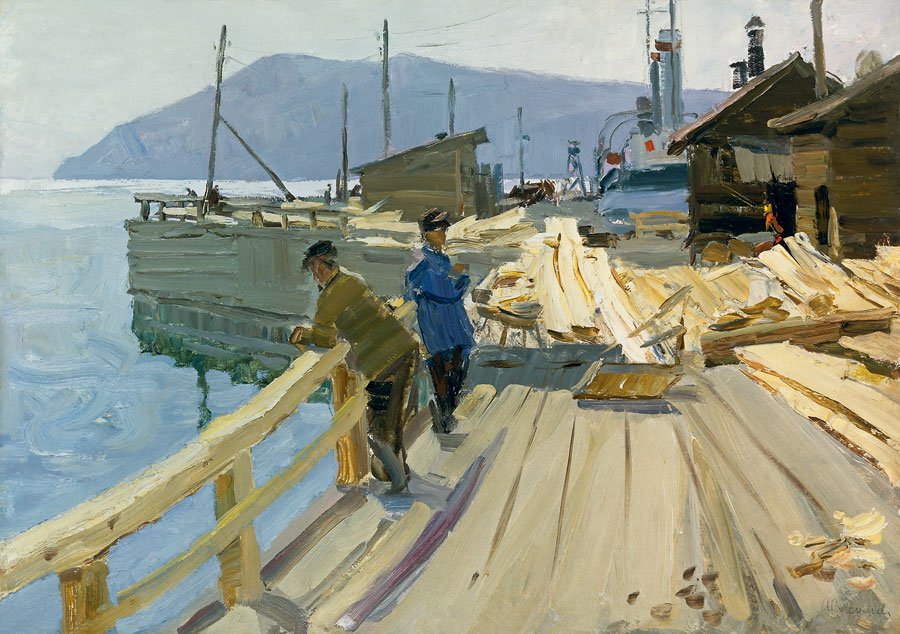 |
||
Anatoli Vasiliev (1917-1994). Baykal Boat Station. At the pier.
Publications:
* Sergei V. Ivanov. Unknown Socialist Realism. The Leningrad School. Saint Petersburg, NP-Print Edition, 2007, plate 31.
* Ленинградские художники. Живопись 1950—1980 годов. Каталог. СПб, Выставочный центр CПСХ, 1994. С.3.
* Этюд в творчестве ленинградских художников. Выставка произведений. Каталог. СПб, Мемориальный музей Н. А. Некрасова, 1994. С.3.
* Васильев А. И. Станция Байкал. У причала. // Иванов С. В. Этюд в багровых тонах // Санкт-Петербургские ведомости. 1994, 9 декабря.
* Лирика в произведениях художников военного поколения. Выставка произведений. Каталог. СПб, Мемориальный музей Н. А. Некрасова, 1995. С.3
* Живопись 1940-1990-х годов. Ленинградская школа. Выставка произведений. СПб, Мемориальный музей Н. А. Некрасова, 1996. С.3.
* Васильев А. И. Станция Байкал. У причала // 80 лет Санкт-Петербургскому Союзу художников. Юбилейная выставка. СПб, Цветпринт, 2012. С.204.
* Васильев Ю. А. Васильев Анатолий Павлович //Страницы памяти. Справочно-биографический сборник. 1941-1945. Художники Санкт-Петербургского (Ленинградского) Союза художников - ветераны Великой Отечественной войны. Кн.1. СПб, Петрополис, 2014. С.177-179.
Provenance:
Private collection. Acquired from artist.
More detail info about artist Biography, Career, and Artistic Creativity, as well as Bibliography please see on Wikipedia:
https://en.wikipedia.org/wiki/Anatoli_Vasiliev
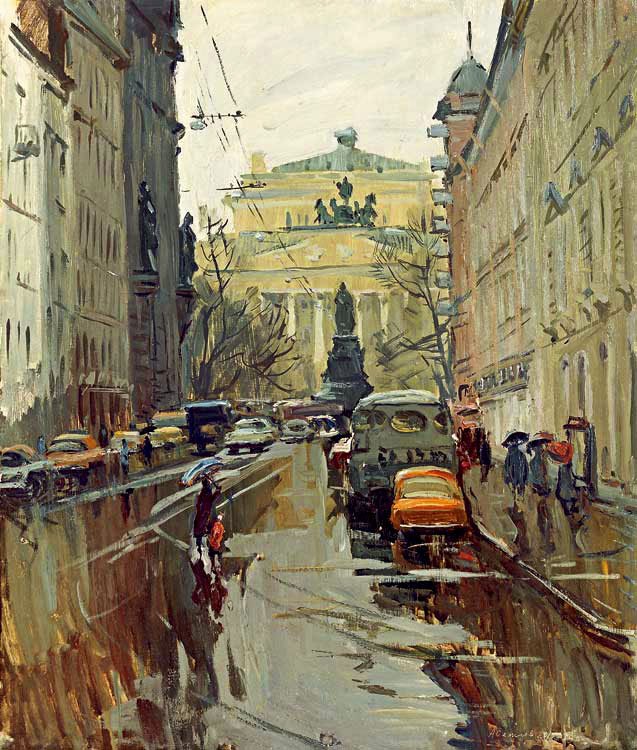 |
||
Alexander Semionov (1922-1984). Malaya Sadovaya Street in the Leningrad.
Publications:
* Sergei V. Ivanov. Unknown Socialist Realism. The Leningrad School. Saint Petersburg, NP-Print Edition, 2007, plate 35.
* Ленинградские художники. Живопись 1950—1980 годов. Каталог. СПб. 1994. С.4.
* Этюд в творчестве ленинградских художников. Выставка произведений. Каталог. СПб, 1994. С.6.
* Живопись 1940-1990 годов. Ленинградская школа. Выставка произведений. СПб, 1996. С.4.
* Иванов С. О ленинградских пейзажах Александра Семёнова // Петербургские искусствоведческие тетради. Вып. 23. СПб, 2012. С.43-46.
* 80 лет Санкт-Петербургскому Союзу художников. Юбилейная выставка. СПб, Цветпринт, 2012. С.209.
Provenance:
Private collection. Acquired from the artist's family.
More detail info about artist Biography, Career, and Artistic Creativity, as well as Bibliography please see on Wikipedia:
https://en.wikipedia.org/wiki/Alexander_Semionov
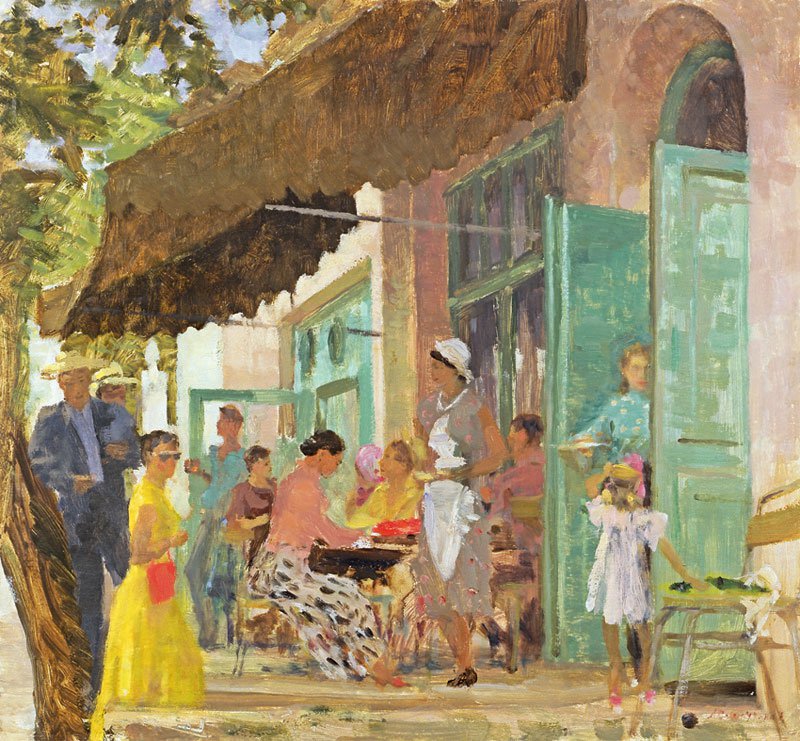 |
||
Alexander Samokhvalov (1894-1971). Cafe Gurzuf.
Publications:
* Sergei V. Ivanov. Unknown Socialist Realism. The Leningrad School. Saint Petersburg, NP-Print Edition, 2007, plate 1.
* Выставка произведений ленинградских художников 1960 года. Каталог. Л., Художник РСФСР, 1963. С.16.
* Александр Николаевич Самохвалов. Выставка произведений. Каталог. Л., Художник РСФСР, 1963. C.20.
* Ленинградские художники. Живопись 1950-1980 годов. Каталог. СПб, Выставочный центр CПСХ, 1994. С.6.
* Самохвалов А. Кафе Гурзуф. 1956 // 80 Лет Санкт-Петербургскому Союзу художников. Юбилейная выставка. СПб, 2012. С.210.
* Иванов С. В. Что движет солнце и светила // Петербургские искусствоведческие тетради. Вып. 34. СПб: 2015.
Provenance:
Private collection. Acquired from the artist's family.
More detail info about artist Biography, Career, and Artistic Creativity, as well as Bibliography please see on Wikipedia:
https://en.wikipedia.org/wiki/Alexander_Nikolayevich_Samokhvalov
https://en.wikipedia.org/wiki/Cafe_Gurzuf_(painting)
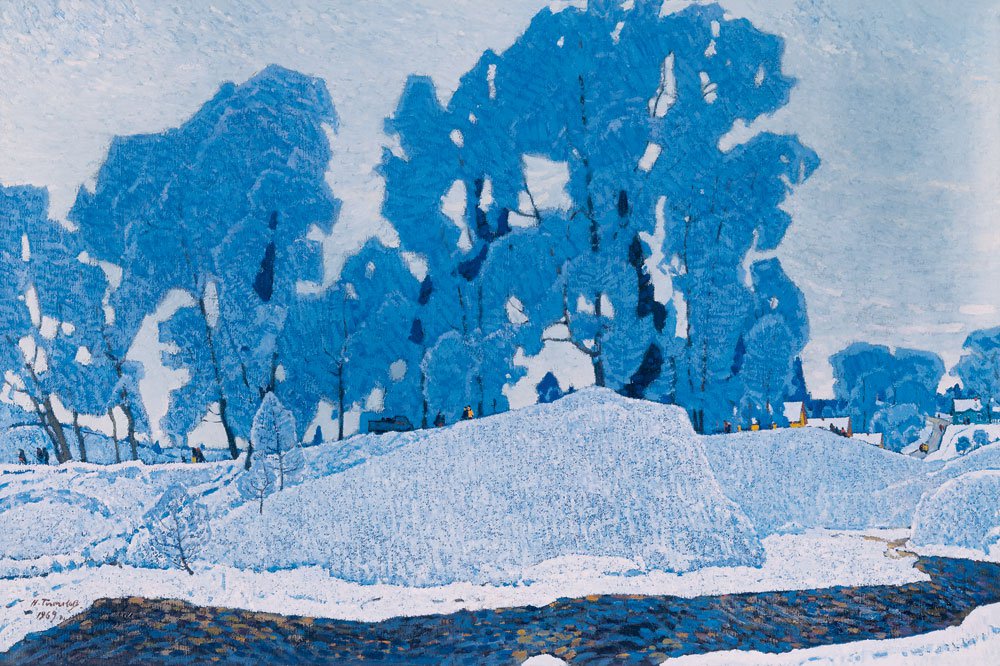 |
||
Nikolai Timkov (1912-1993). Russian Winter.
Publications:
* Sergei V. Ivanov. Unknown Socialist Realism. The Leningrad School. Saint Petersburg, NP-Print Edition, 2007, plate 20.
* Exhibition of works by Nikolai Efimovich Timkov. Catalogue. Leningrad, Khudozhnik RSFSR, 1975.
* Saint-Pétersbourg - Pont-Audemer. Dessins, Gravures, Sculptures et Tableaux du XX siècle du fonds de L' Union des Artistes de Saint-Pétersbourg. Pont-Audemer, 1994. P.110.
* Тимков Н. Русская зима. Иней. 1969 // 80 Лет Санкт-Петербургскому Союзу художников. Юбилейная выставка. СПб., 2012. С.211.
Provenance:
Private collection. Acquired from the artist's family.
More detail info about artist Biography, Career, and Artistic Creativity, as well as Bibliography please see on Wikipedia:
https://en.wikipedia.org/wiki/Nikolai_Timkov
https://en.wikipedia.org/wiki/Russian_Winter._Hoarfrost_%28painting%29
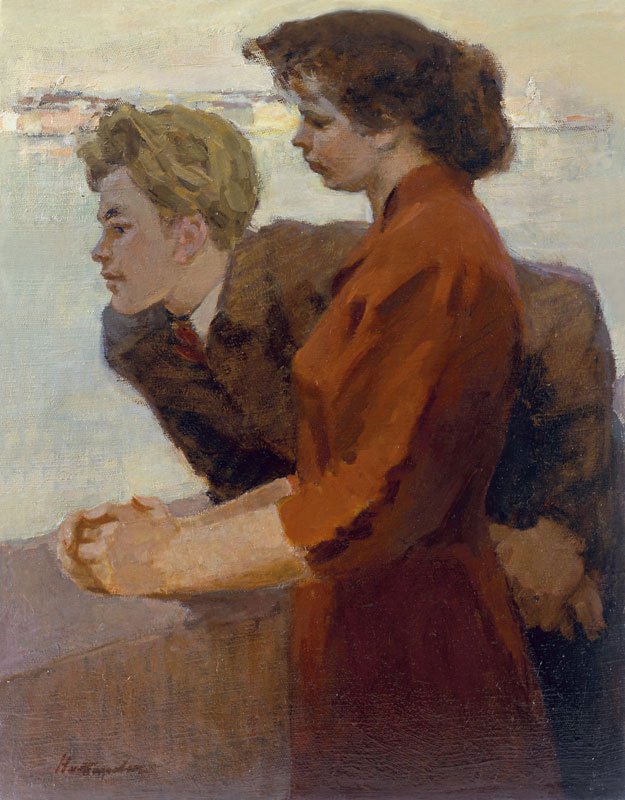 |
||
Mikhail Natarevich (1907-1979). A Youth.
Publications:
* Sergei V. Ivanov. Unknown Socialist Realism. The Leningrad School. Saint Petersburg, NP-Print Edition, 2007, plate 36.
* Ленинградские художники. Живопись 1950-1980 годов. Каталог. СПб, Выставочный центр СПСХ, 1994. С.4.
* Этюд в творчестве ленинградских художников. Выставка произведений. Каталог. СПб, Мемориальный музей Н. А. Некрасова, 1994. С.4.
* Живопись 1940-1990 годов. Ленинградская школа. Выставка произведений. СПб, Мемориальный музей Н. А. Некрасова, 1996. С.4.
Provenance:
Private collection. Acquired from the artist's family.
More detail info about artist Biography, Career, and Artistic Creativity, as well as Bibliography please see on Wikipedia:
https://en.wikipedia.org/wiki/Mikhail_Natarevich
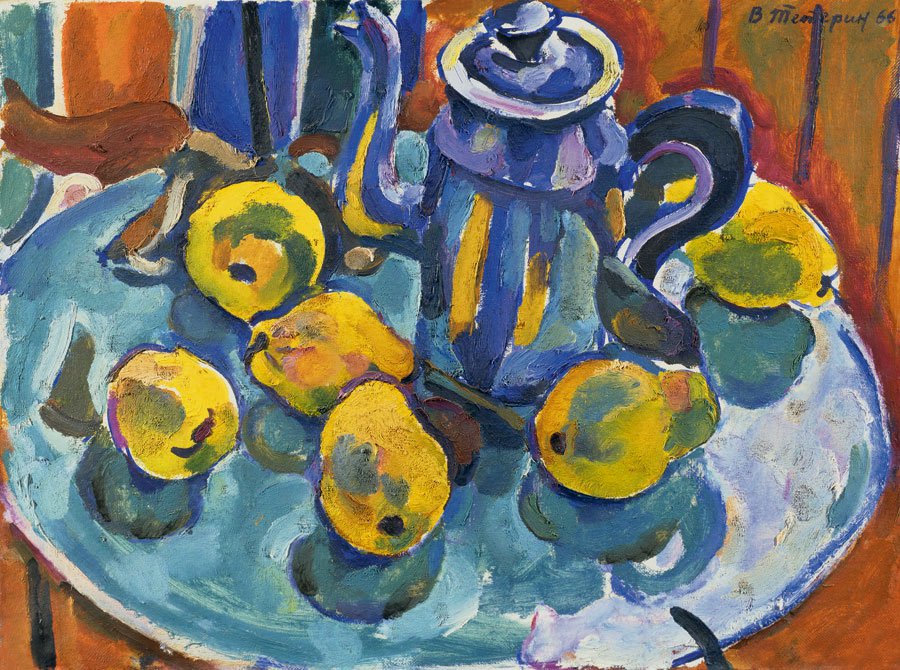 |
||
Victor Teterin (1922-1991). Quince and Teapot.
Publications:
* Sergei V. Ivanov. Unknown Socialist Realism. The Leningrad School. Saint Petersburg, NP-Print Edition, 2007, plate 51.
* Каталог выставки одиннадцати ленинградских художников. Л., Художник РСФСР, 1976.
* Виктор Кузьмич Тетерин. Выставка произведений. Каталог. Л., Художник РСФСР, 1988. С.6, 27.
* Евгения Антипова, Виктор Тетерин. Живопись. Рисунок. СПб, ЗАО «ПОНИ», 1999.
* Памяти учителя. Выставка петербургских художников - учеников мастерской А. А. Осмёркина. СПб, Мемориальный музей Н. А. Некрасова, 1997. С.4,5.
* Художники круга 11-ти. СПб, Мемориальный музей Н. А. Некрасова, 2001. С.3.
* Иванов С. Тихая жизнь за ленинградским столом // Петербургские искусствоведческие тетради. Выпуск 23. СПб, 2012. С.90-97.
* Тетерин В. К. Айва и чайник // 80 лет Санкт-Петербургскому Союзу художников. Юбилейная выставка. СПб, Цветпринт, 2012. С.211.
Provenance:
Private collection. Acquired from the artist's family.
More detail info about artist Biography, Career, and Artistic Creativity, as well as Bibliography please see on Wikipedia:
https://en.wikipedia.org/wiki/Victor_Teterin
See also: https://en.wikipedia.org/wiki/Quince_and_Teapot_%28painting%29
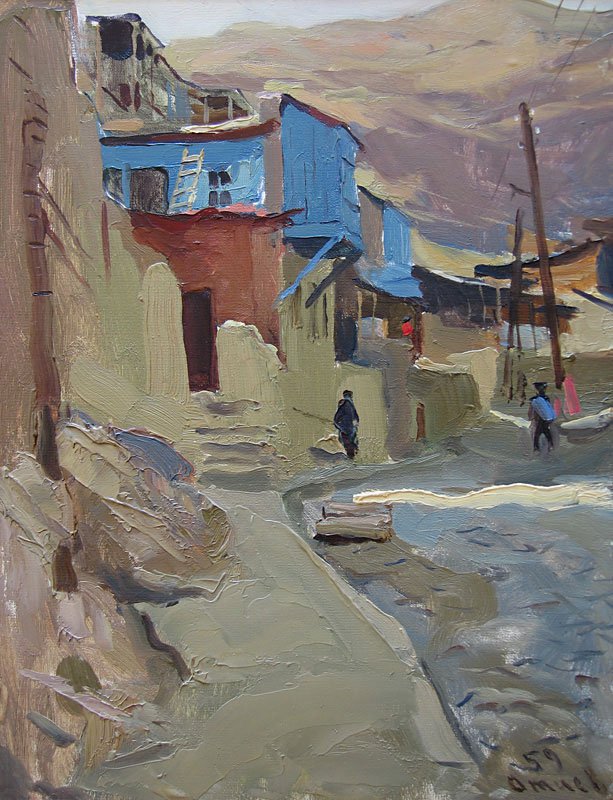 |
||
Victor Otiev (1935-1999). Tbilisi Old Town.
Publications:
* Sergei V. Ivanov. Unknown Socialist Realism. The Leningrad School. Saint Petersburg, NP-Print Edition, 2007, plate 164.
* Отиев, В. А. Старый Тбилиси // 80 лет Санкт-Петербургскому Союзу художников. Юбилейная выставка. СПб, Цветпринт, 2012. С.207.
Provenance:
Private collection. Acquired from the artist's studio.
For more details about artist Biography, Career, and Artistic Creativity, as well as Bibliography please visit Wikipedia:
https://en.wikipedia.org/wiki/Victor_Otiev
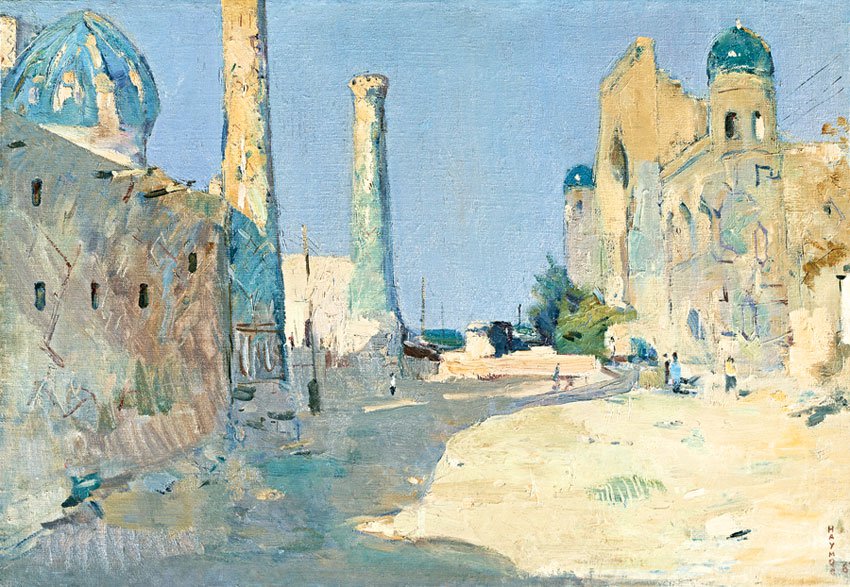 |
||
Alexander Naumov (1935-2010). Samarkhand. The Registan.
Publications:
* Sergei V. Ivanov. Unknown Socialist Realism. The Leningrad School. Saint Petersburg, NP-Print Edition, 2007, plate 159.
* Ленинградские художники. Живопись 1950-1980 годов. Каталог. СПб, Выставочный центр Санкт-Петербургского Союза художников, 1994. С.4.
* Этюд в творчестве ленинградских художников. Выставка произведений. Каталог. СПб, Мемориальный музей Н. А. Некрасова, 1994. С.4.
* Наумов А. А. Самарканд. Регистан // 80 лет Санкт-Петербургскому Союзу художников. Юбилейная выставка. CПб, Цветпринт, 2012. C.206.
Provenance:
Private collection. Acquired from the artist's studio.
For more details about artist Biography, Career, and Artistic Creativity, as well as Bibliography please visit Wikipedia:
https://en.wikipedia.org/wiki/Alexander_Naumov
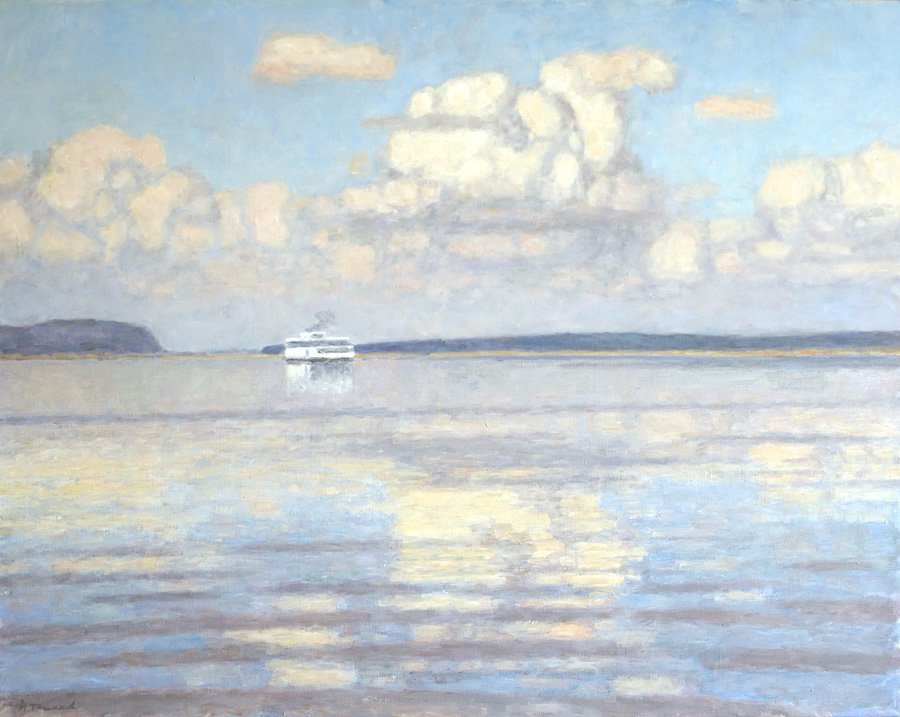 |
||
Nikolai Galakhov (b. 1928). Clouds over Volga River.
Provenance:
Private collection. Acquired from the artist studio.
More detail info about artist Biography, Career, and Artistic Creativity, as well as Bibliography please see on Wikipedia:
https://en.wikipedia.org/wiki/Nikolai_Galakhov
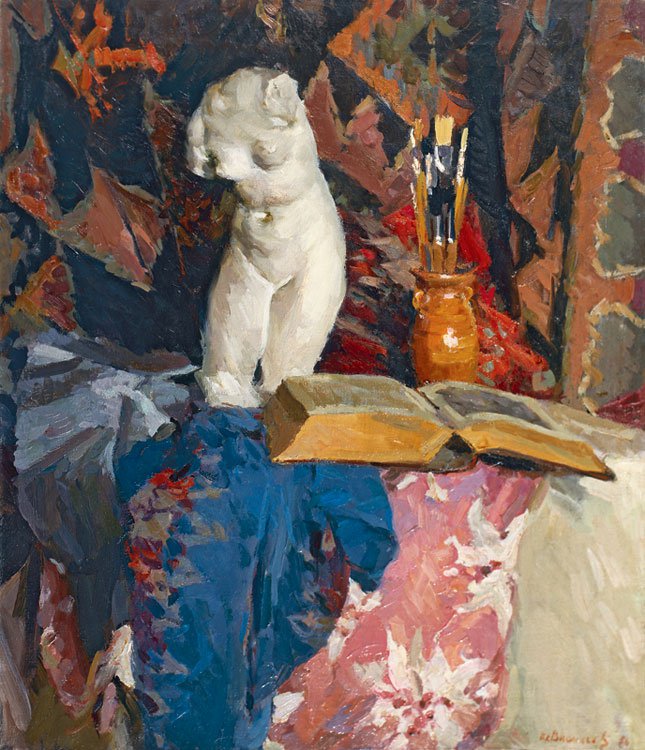 |
||
Piotr Vasiliev (1908-1989). Still-life with a book.
Publications:
* Sergei V. Ivanov. Unknown Socialist Realism. The Leningrad School. Saint Petersburg, NP-Print Edition, 2007, plate 56.
* Лирика в произведениях художников военного поколения. Выставка произведений. Каталог. СПб, Мемориальный музей Н. А. Некрасова, 1995. С.3.
* Натюрморт в живописи 1940-1990 годов. Ленинградская школа. Каталог выставки. СПб, 1997. С. 3.
Provenance:
Private collection. Acquired from the artist's family.
For more details about artist Biography, Career, and Artistic Creativity, as well as Bibliography please visit Wikipedia:
https://en.wikipedia.org/wiki/Piotr_Vasiliev
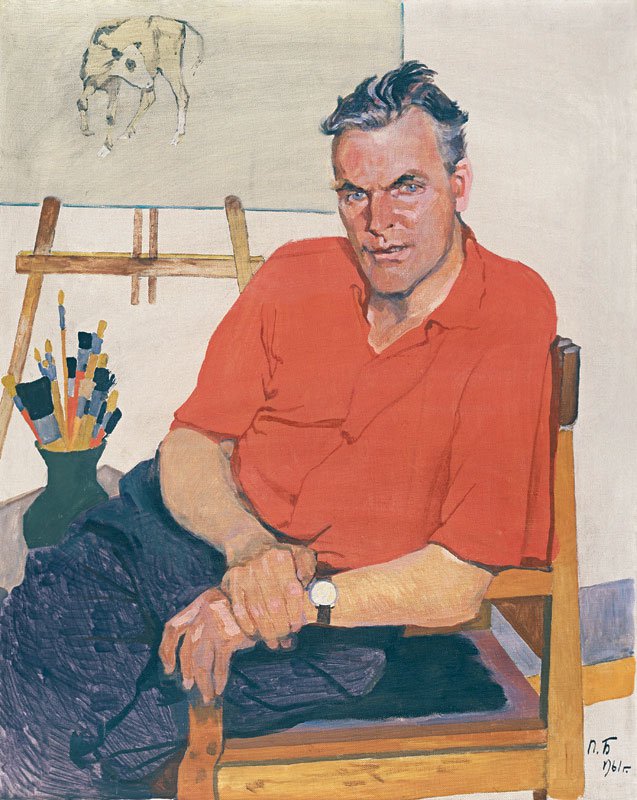 |
||
Piotr Buchkin (1886-1965). Portrait of artist Piotr Vasiliev.
Publications:
Sergei V. Ivanov. Unknown Socialist Realism. The Leningrad School. Saint Petersburg, NP-Print Edition, 2007, plate 57.
Provenance:
Private collection. Acquired from the artist's family.
For more details about artist Biography, Career, and Artistic Creativity, as well as Bibliography please see Wikipedia:
https://en.wikipedia.org/wiki/Piotr_Buchkin
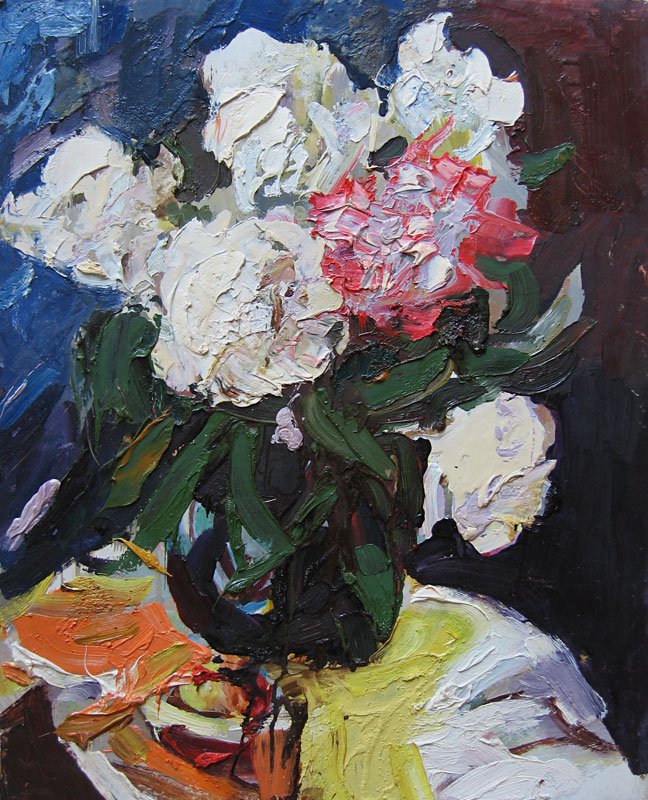 |
||
Alexander Korovialov (1912-1993). A Bouquet.
Provenance:
Private collection. Acquired from the artist's family.
For more details about artist Biography, Career, and Artistic Creativity, as well as Bibliography please visit Wikipedia:
https://en.wikipedia.org/wiki/Alexander_Koroviakov
 |
||
Gleb Savinov (1915-2000). Country Store.
Publications:
* Sergei V. Ivanov. Unknown Socialist Realism. The Leningrad School. Saint Petersburg, NP-Print Edition, 2007, plate 62.
* Леонова Н. Г. Глеб Александрович Савинов. Л., Художник РСФСР, 1988. C.80.
Provenance:
Private collection. Acquired from the artist's family.
For more details about artist Biography, Career, and Artistic Creativity, as well as Bibliography please see Wikipedia:
https://en.wikipedia.org/wiki/Gleb_Savinov
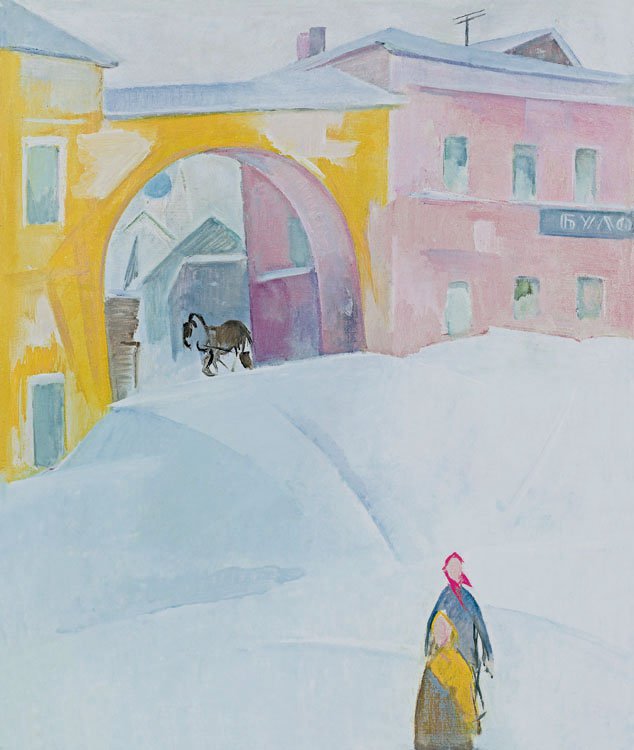 |
||
Sergei Osipov (1915-1985). House with Arch.
Publications:
* Sergei V. Ivanov. Unknown Socialist Realism. The Leningrad School. Saint Petersburg, NP-Print Edition, 2007, plate 17.
* Сергей Иванович Осипов. Живопись. Рисунок. Выставка произведений. Каталог. Л., Художник РСФСР, 1990. С.9.
* Ленинградские художники. Живопись 1950-1980 годов. Каталог СПб, 1994. С.4.
* Иванов С. Двадцать лет спустя. Размышления о выставке Сергея Осипова // Петербургские искусствоведческие тетради. Вып. 21. СПб, 2011.
Provenance:
Private collection. Acquired from the artist's family.
For more details about artist Biography, Career, and Artistic Creativity, as well as Bibliography please see Wikipedia:
https://en.wikipedia.org/wiki/Sergei_Ivanovich_Osipov
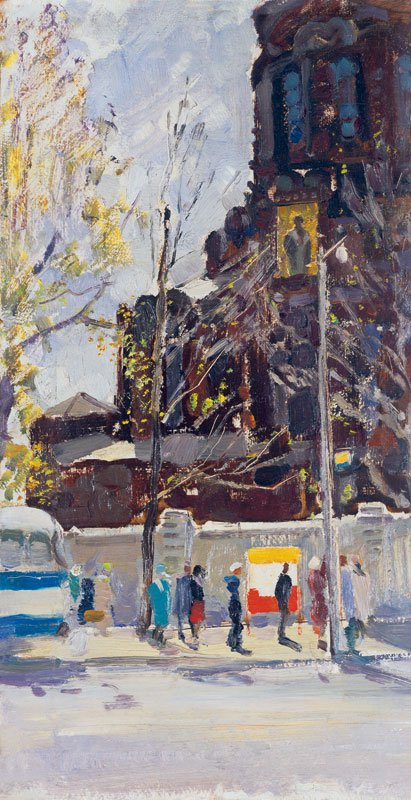 |
||
Piotr Litvinsky (1927-2009). Spring in the city.
Publications:
* Sergei V. Ivanov. Unknown Socialist Realism. The Leningrad School. Saint Petersburg, NP-Print Edition, 2007, plate 334.
* Ленинградские художники. Живопись 1950-1980 годов. Каталог. СПб, Выставочный центр Санкт-Петербургского Союза художников, 1994. С.3.
* Этюд в творчестве ленинградских художников. Выставка произведений. Каталог. СПб, Мемориальный музей Н. А. Некрасова, 1994. С.4.
* Лирика в произведениях художников военного поколения. Выставка произведений. Каталог. СПб, Мемориальный музей Н. А. Некрасова, 1995. С.4.
* Живопись 1940-1990 годов. Ленинградская школа. Выставка произведений. СПб, Мемориальный музей Н. А. Некрасова, 1996. С.3.
Provenance:
Private collection. Acquired from the artist's family.
For more details about artist Biography, Career, and Artistic Creativity, as well as Bibliography please visit Wikipedia:
https://en.wikipedia.org/wiki/Piotr_Litvinsky
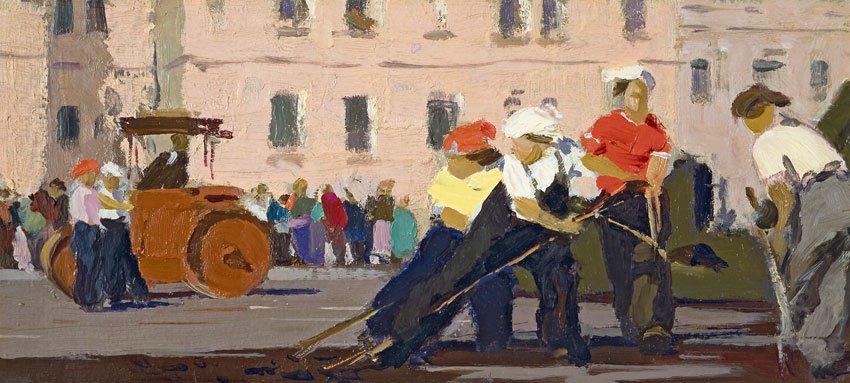 |
||
Anatoli Nenartovich (1915-1988). Women Laing Asphalt.
Publications:
* Sergei V. Ivanov. Unknown Socialist Realism. The Leningrad School. Saint Petersburg, NP-Print Edition, 2007, plate 142.
* Ленинградские художники. Живопись 1950-1980 годов. Каталог. СПб, Выставочный центр СПСХ, 1994. С.4.
* Этюд в творчестве ленинградских художников. Выставка произведений. Каталог. СПб, 1994. С.4.
* Лирика в произведениях художников военного поколения. Выставка произведений. Каталог. СПб, 1995. С.4.
* Живопись 1940-1990 годов. Ленинградская школа. Выставка произведений. Каталог. СПб, 1996. С.4.
* Ненартович А. А. Асфальтировщицы // 80 лет Санкт-Петербургскому Союзу художников. Юбилейная выставка. Пб, Цветпринт, 2012. С.206.
Provenance:
Private collection. Acquired from the artist's family.
For more details about artist Biography, Career, and Artistic Creativity, as well as Bibliography please see Wikipedia:
https://en.wikipedia.org/wiki/Anatoli_Nenartovich
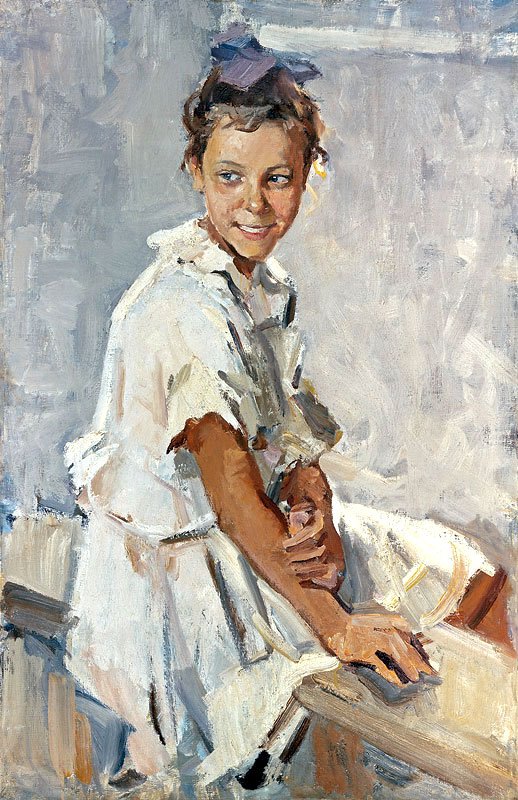 |
||
Lev Russov (1926-1987). Zoya. - Lev Russov
Publications:
* Sergei V. Ivanov. Unknown Socialist Realism. The Leningrad School. Saint Petersburg, NP-Print Edition, 2007, plate 15.
* Этюд в творчестве ленинградских художников. Выставка произведений. Каталог. СПб, 1994. С.6.
* Русов Л. А. Зоя // Иванов С. В. Этюд в багровых тонах // Санкт-Петербургские ведомости. 1994, 9 декабря.
* Иванов С. О ранних портретах Льва Русова // Петербургские искусствоведческие тетради. Выпуск 23. СПб, 2012. С.7-15.
Provenance:
Private collection. Acquired from the artist's family.
For more details about artist Biography, Career, and Artistic Creativity, as well as Bibliography please see Wikipedia:
https://en.wikipedia.org/wiki/Lev_Russov
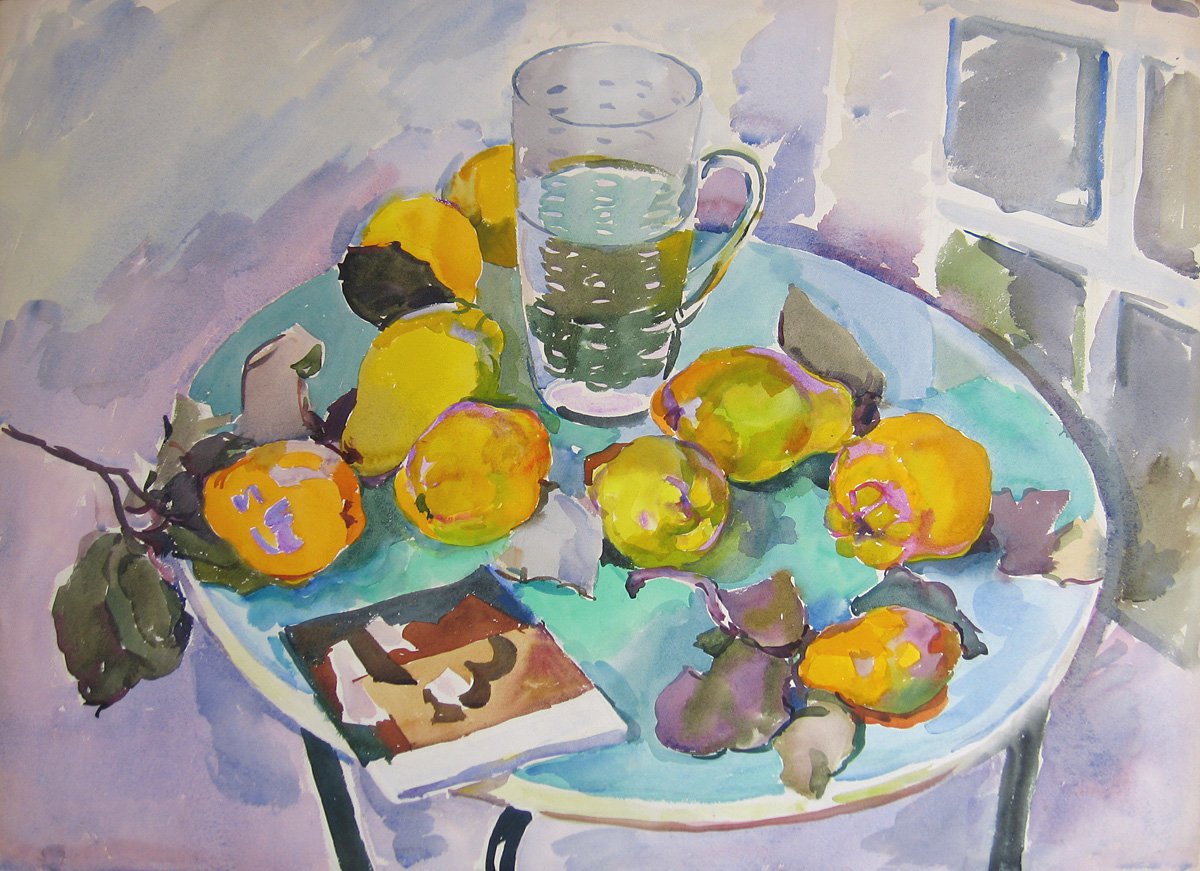 |
||
Evgenia Antipova (1917-2009). Quince on the Green Table.
Provenance:
Private collection. Acquired from the artist's studio.
For more details about artist Biography, Career, and Artistic Creativity, as well as Bibliography please see Wikipedia:
https://en.wikipedia.org/wiki/Evgenia_Antipova
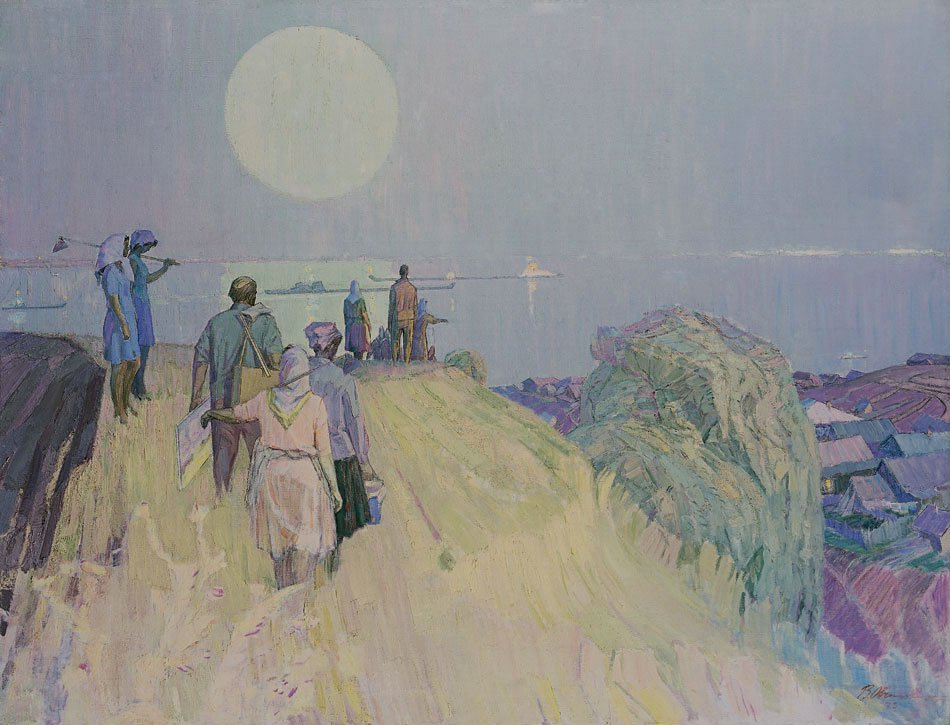 |
||
Vladimir Ovchinnikov (1911-1978). Evening on the Volga River. - Vladimir Ovchinnikov
Publications:
* Sergei V. Ivanov. Unknown Socialist Realism. The Leningrad School. Saint Petersburg, NP-Print Edition, 2007, plate 82.
* Иванов С. Владимир Овчинников в воспоминаниях современников. К 100-летию со дня рождения // Петербургские искусствоведческие тетради. Выпуск 21. СПб, 2011. С.46-53.
* Иванов С. В. Овчинников Владимир Иванович // Страницы памяти. Справочно-биографический сборник. 1941—1945. Художники Санкт-Петербургского (Ленинградского) Союза художников — ветераны Великой Отечественной войны. СПб: Петрополис, 2014. Кн. 2. С. 142—144.
Provenance:
Private collection. Acquired from the artist's family.
For more details about artist Biography, Career, and Artistic Creativity, as well as Bibliography please see Wikipedia:
https://en.wikipedia.org/wiki/Vladimir_Ovchinnikov_%28painter%29
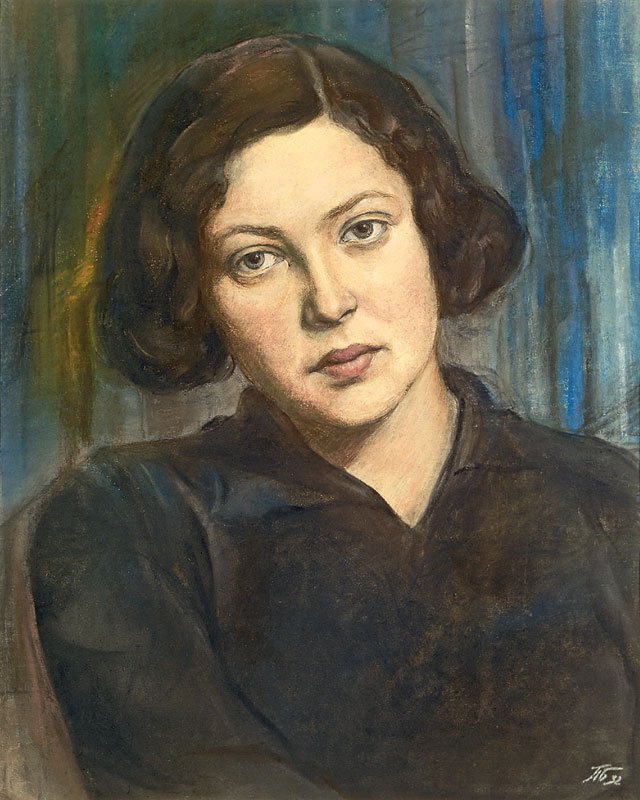 |
||
Poitr Belousov (1912-1989). Portrait of young woman.
Publications:
* Sergei V. Ivanov. Unknown Socialist Realism. The Leningrad School. Saint Petersburg, NP-Print Edition, 2007, plate 4.
* Ленинградские художники. Живопись 1950-1980 годов. Каталог. СПб, 1994. С.3.
* Лирика в произведениях художников военного поколения. Выставка произведений. Каталог. СПб, 1995. С.3.
* Белоусов П. П. Портрет молодой женщины // 80 лет Санкт-Петербургскому Союзу художников. Юбилейная выставка. СПб: Цветпринт, 2012. С.207.
Provenance:
Private collection. Acquired from the artist's family.
For more details about artist Biography, Career, and Artistic Creativity, as well as Bibliography please see Wikipedia:
https://en.wikipedia.org/wiki/Piotr_Belousov
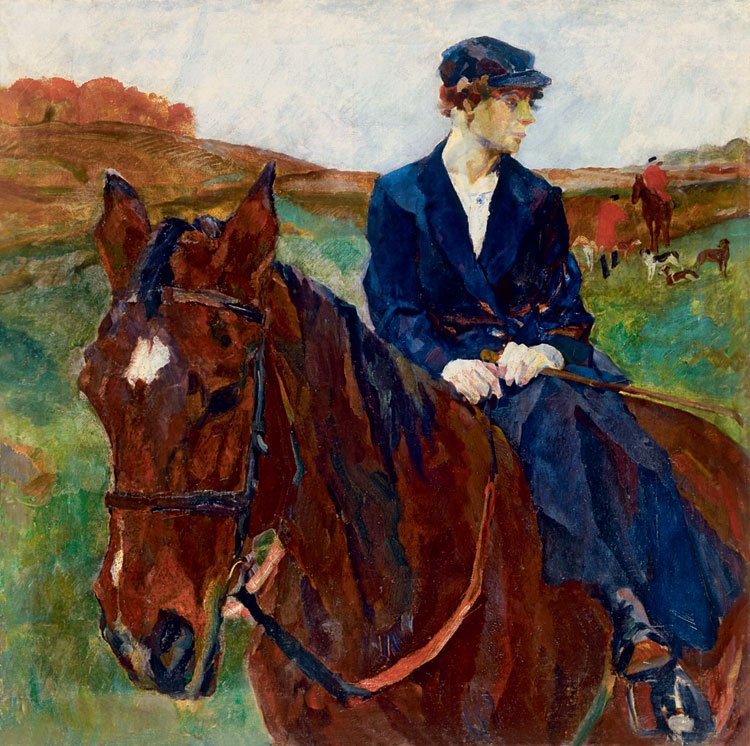 |
||
Rudolf Frentz (1888-1956). Horsewomen.
Publications:
* Выставка художника Р. Р. Френца. Апрель-май. Каталог. Л., Община художников, 1928.
* Рудольф Рудольфович Френц. Каталог выставки. Л., Художник РСФСР, 1970. С.10.
* Sergei V. Ivanov. Unknown Socialist Realism. The Leningrad School. Saint Petersburg, NP-Print Edition, 2007, plate 2.
Provenance:
Private collection. Acquired from the artist's family.
For more details about artist Biography, Career, and Artistic Creativity, as well as Bibliography please visit Wikipedia:
https://en.wikipedia.org/wiki/Rudolf_Frentz
See also: https://en.wikipedia.org/wiki/Horsewoman_%28painting%29
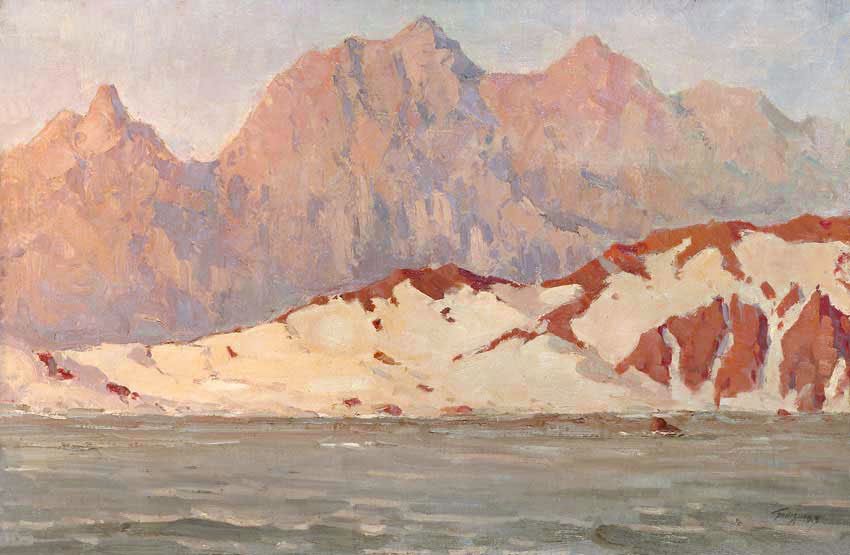 |
||
Vsevolod Bazhenov (1908-1986). Arabian coast.
Publications:
* Sergei V. Ivanov. Unknown Socialist Realism. The Leningrad School. Saint Petersburg, NP-Print Edition, 2007, plate 150.
* Ленинградские художники. Живопись 1950—1980 годов. Каталог. СПб, 1994. С.3.
* Всеволод Баженов. Живопись. К 85-летию со дня рождения. Выставка произведений. Каталог. СПб, 1994.
Provenance:
Private collection. Acquired from the artist's family.
For more details about artist Biography, Career, and Artistic Creativity, as well as Bibliography please see Wikipedia:
https://en.wikipedia.org/wiki/Vsevolod_Bazhenov
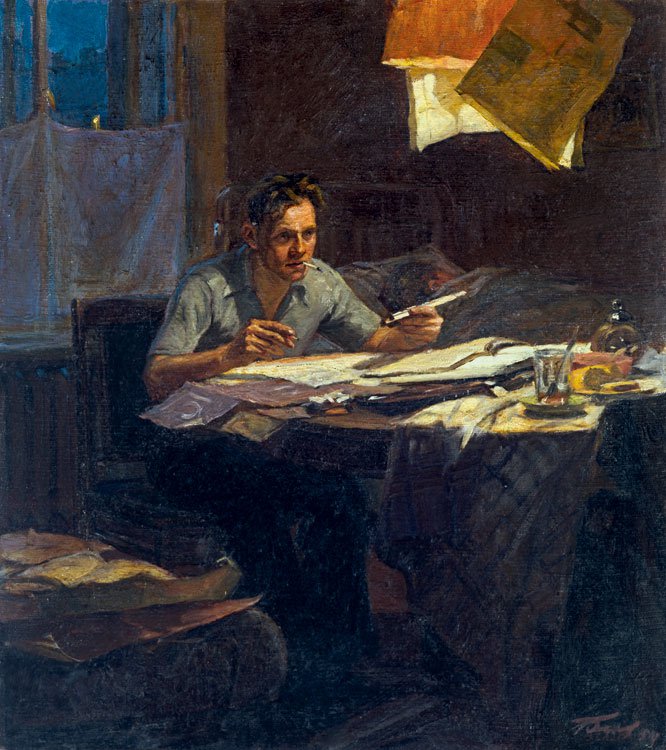 |
||
Yuri Belov (b. 1929). Worker - Innovator.
Publications:
Sergei V. Ivanov. Unknown Socialist Realism. The Leningrad School. Saint Petersburg, NP-Print Edition, 2007, plate 151.
Provenance:
Private collection. Acquired from the artist's studio.
For more details about artist Biography, Career, and Artistic Creativity, as well as Bibliography please see Wikipedia:
https://en.wikipedia.org/wiki/Yuri_Belov
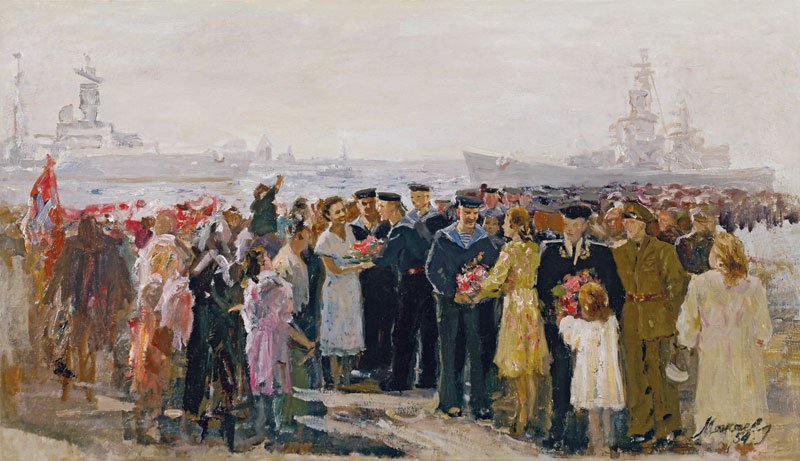 |
||
Alexei Mozhaev (1918-1994). Grand Reception of sailors in Leningrad.
Publications:
Sergei V. Ivanov. Unknown Socialist Realism. The Leningrad School. Saint Petersburg, NP-Print Edition, 2007, plate 263.
Provenance:
Private collection. Acquired from the artist's family.
For more details about artist Biography, Career, and Artistic Creativity, as well as Bibliography please visit Wikipedia:
https://en.wikipedia.org/wiki/Alexei_Mozhaev
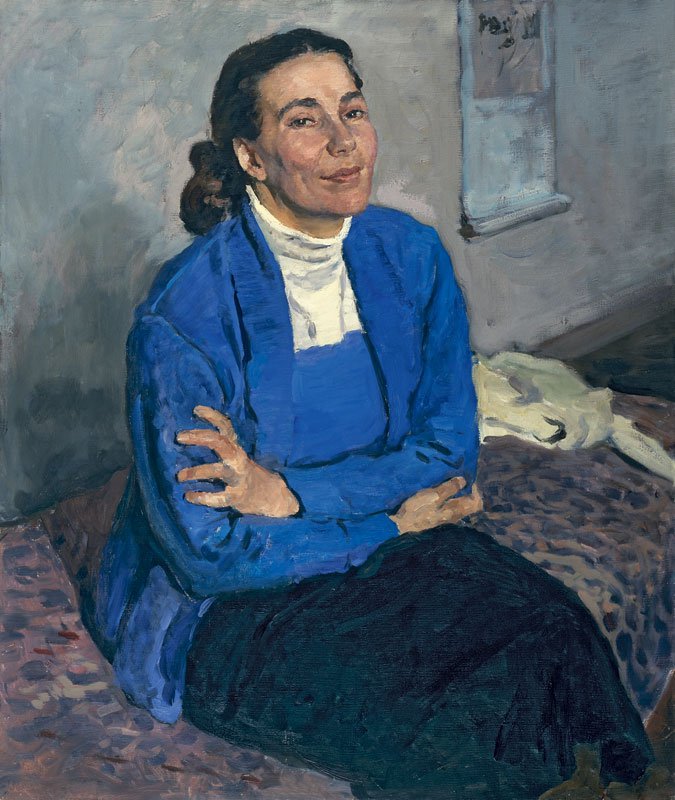 |
||
Alexander Pushnin (1921-1991). Portrait of artist Tatiana Kopnina.
Publications:
Sergei V. Ivanov. Unknown Socialist Realism. The Leningrad School. Saint Petersburg, NP-Print Edition, 2007, plate 186.
Provenance:
Private collection. Acquired from the artist's family.
For more details about artist Biography, Career, and Artistic Creativity, as well as Bibliography please visit Wikipedia:
https://en.wikipedia.org/wiki/Alexander_Pushnin
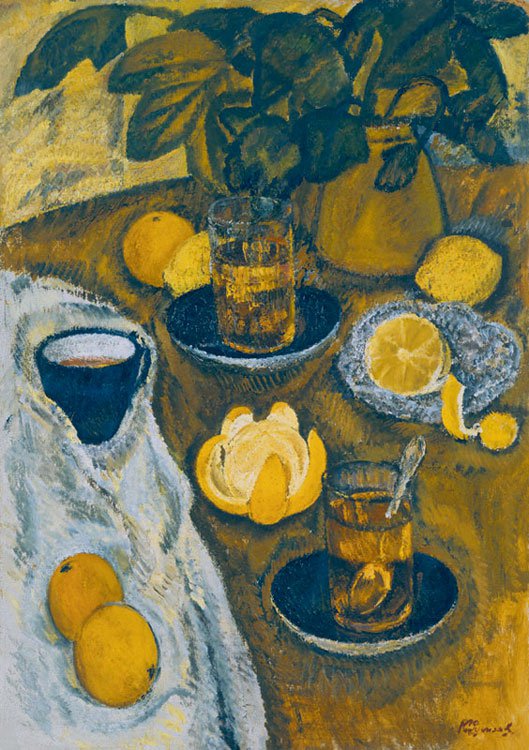 |
||
Kapitolina Rumiantseva (1925-2002). Still-life with oranges.
Publications:
* Sergei V. Ivanov. Unknown Socialist Realism. The Leningrad School. Saint Petersburg, NP-Print Edition, 2007, plate 130.
* Ленинградские художники. Живопись 1950-1980 годов. Каталог. СПб, Выставочный центр Санкт-Петербургского Союза художников, 1994. С.6.
* Натюрморт в живописи 1940-1990 годов. Ленинградская школа. Каталог выставки. СПб, 1997. С. 4.
Provenance:
Private collection. Acquired from the artist's studio.
For more details about artist Biography, Career, and Artistic Creativity, as well as Bibliography please visit Wikipedia:
https://en.wikipedia.org/wiki/Kapitolina_Rumiantseva
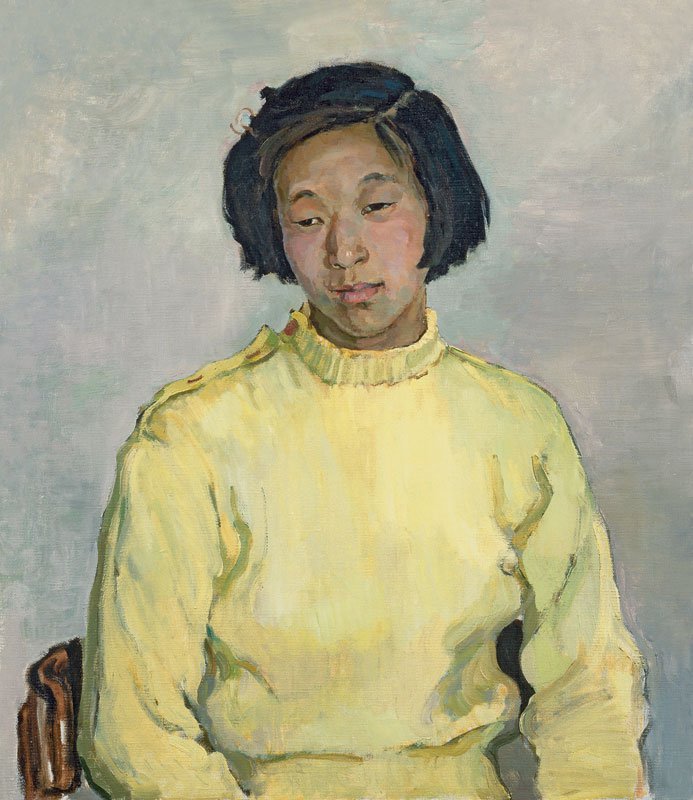 |
||
Tatiana Kopnina (1921-2009). Portrait of Chinese student.
Publications:
Sergei V. Ivanov. Unknown Socialist Realism. The Leningrad School. Saint Petersburg, NP-Print Edition, 2007, plate 322.
Provenance:
Private collection. Acquired from the artist's family.
For more details about artist Biography, Career, and Artistic Creativity, as well as Bibliography please visit Wikipedia:
https://en.wikipedia.org/wiki/Tatiana_Kopnina
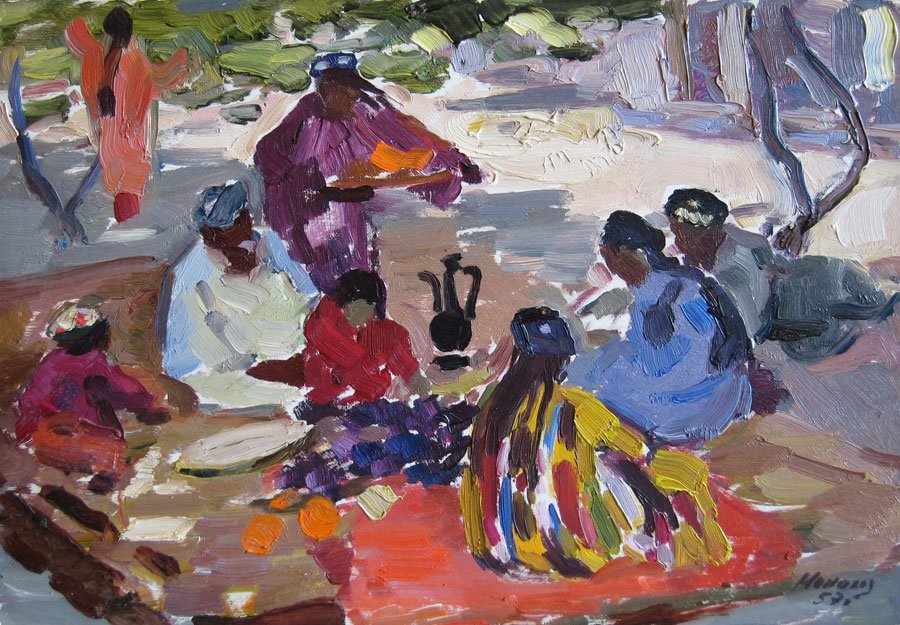 |
||
Valentina Monakhova (b. 1932). Midday in Urgut.
Publications:
* Sergei V. Ivanov. Unknown Socialist Realism. The Leningrad School. Saint Petersburg, NP-Print Edition, 2007, plate 160.
* Этюд в творчестве ленинградских художников. Выставка произведений. Каталог. СПб, Мемориальный музей Н. А. Некрасова, 1994. С. 4.
* Лирика в произведениях художников военного поколения. Выставка произведений. Каталог. СПб, Мемориальный музей Н. А. Некрасова, 1995. С. 4.
* Живопись 1940-1990 годов. Ленинградская школа. Выставка произведений. СПб, Мемориальный музей Н. А. Некрасова, 1996. С.3-4.
Provenance:
Private collection. Acquired from the artist's studio.
For more details about artist Biography, Career, and Artistic Creativity, as well as Bibliography please see Wikipedia:
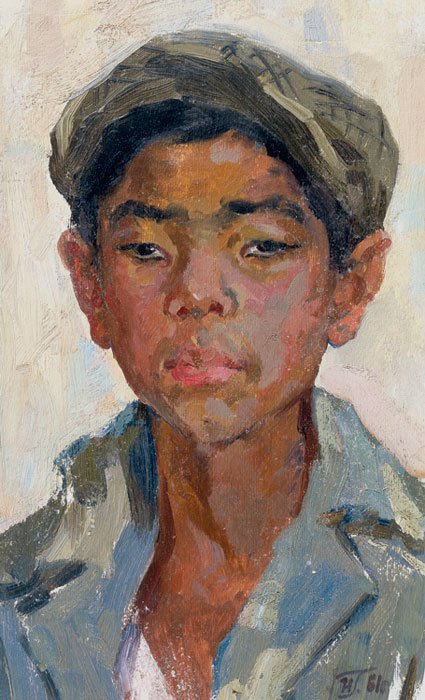 |
||
Irina Getmanskaya (b. 1939). Kirgiz boy.
Publications:
Sergei V. Ivanov. Unknown Socialist Realism. The Leningrad School. Saint Petersburg, NP-Print Edition, 2007, plate 161.
Provenance:
Private collection. Acquired from the artist's studio.
For more details about artist Biography, Career, and Artistic Creativity, as well as Bibliography please see Wikipedia:
https://en.wikipedia.org/wiki/Irina_Getmanskaya
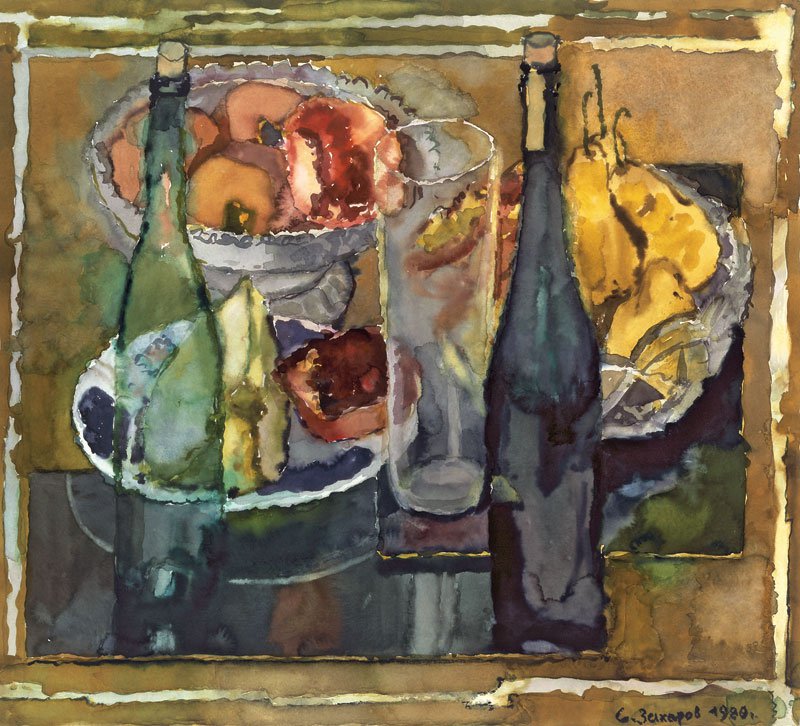 |
||
Sergei Zakharov (1900-1993). Still life with pomegranates.
Publications:
Sergei V. Ivanov. Unknown Socialist Realism. The Leningrad School. Saint Petersburg, NP-Print Edition, 2007, plate 50.
Provenance:
Private collection. Acquired from the artist's family.
For more details about artist Biography, Career, and Artistic Creativity, as well as Bibliography please see Wikipedia:
https://en.wikipedia.org/wiki/Sergei_Yefimovich_Zakharov
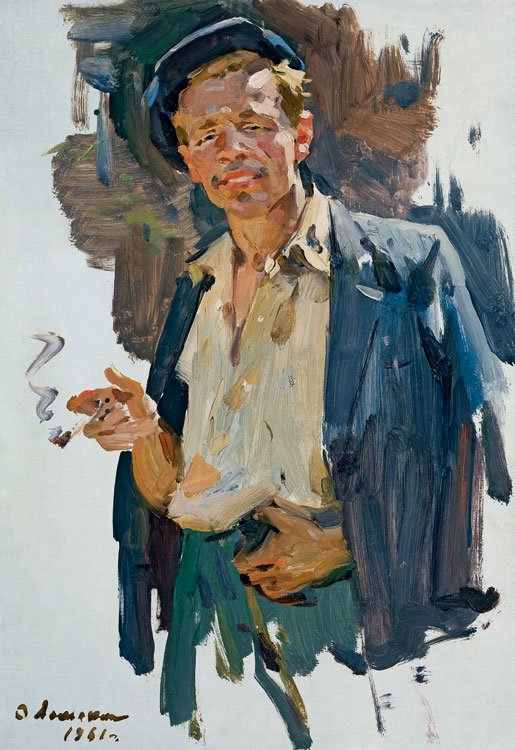 |
||
Oleg Lomakin (1924-2010). Smoking Man.
Publications:
Sergei V. Ivanov. Unknown Socialist Realism. The Leningrad School. Saint Petersburg, NP-Print Edition, 2007, plate 21.
Provenance:
Private collection. Acquired from the artist's studio.
For more details about artist Biography, Career, and Artistic Creativity, as well as Bibliography please visit Wikipedia:
https://en.wikipedia.org/wiki/Oleg_Lomakin
 |
||
Dmitry Maevsky (1917-1992). March sun.
Publications:
* Sergei V. Ivanov. Unknown Socialist Realism. The Leningrad School. Saint Petersburg, NP-Print Edition, 2007, plate 95.
* Маевский Д. И. Мартовское солнце // 80 лет Санкт-Петербургскому Союзу художников. Юбилейная выставка. CПб, Цветпринт, 2012. С.206.
Provenance:
Private collection. Acquired from the artist's studio.
For more details about artist Biography, Career, and Artistic Creativity, as well as Bibliography please visit Wikipedia:
https://en.wikipedia.org/wiki/Dmitry_Maevsky
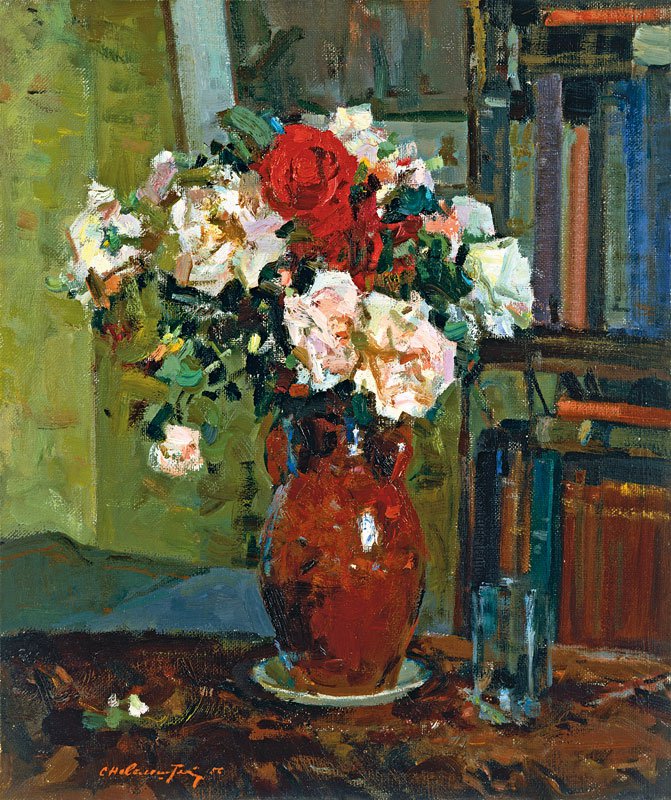 |
||
Samuil Nevelshtein (1903-1983). Roses.
Publications:
* Sergei V. Ivanov. Unknown Socialist Realism. The Leningrad School. Saint Petersburg, NP-Print Edition, 2007, plate 155.
* Ленинградские художники. Живопись 1950-1980 годов. Каталог. СПб, Выставочный центр Санкт-Петербургского Союза художников, 1994. С.4.
* Этюд в творчестве ленинградских художников. Выставка произведений. Каталог. СПб, Мемориальный музей Н. А. Некрасова, 1994. С.4.
* Лирика в произведениях художников военного поколения. Выставка произведений. Каталог. СПб, Мемориальный музей Н. А. Некрасова, 1995. С.4.
* Живопись 1940-1990 годов. Ленинградская школа. Выставка произведений. СПб, Мемориальный музей Н. А. Некрасова, 1996. С.4.
* Натюрморт в живописи 1940-1990 годов. Ленинградская школа. Каталог выставки. СПб, 1997. С. 4.
* Невельштейн С. Г. Розы // 80 лет Санкт-Петербургскому Союзу художников. Юбилейная выставка. CПб., Цветпринт, 2012. С.207.
Provenance:
Private collection. Acquired from the artist's family.
For more details about artist Biography, Career, and Artistic Creativity, as well as Bibliography please visit Wikipedia:
https://en.wikipedia.org/wiki/Samuil_Nevelshtein
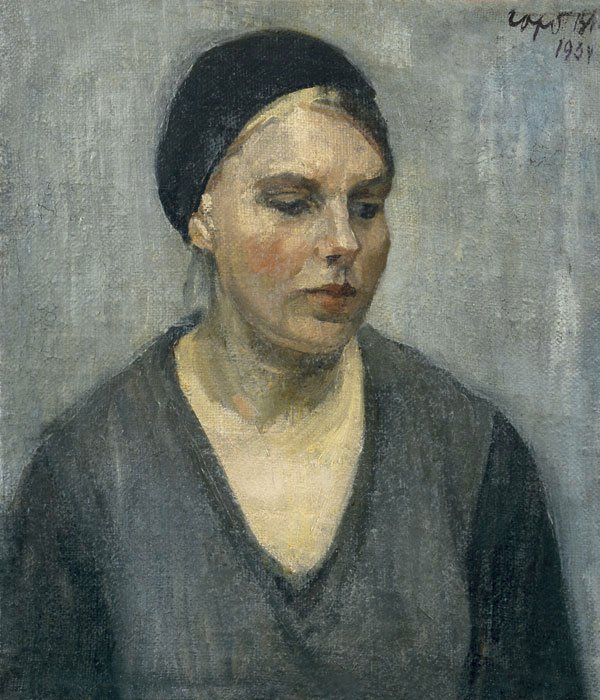 |
||
Vladimir Gorb (1903-1986). Young woman in black beret.
Publications:
* Sergei V. Ivanov. Unknown Socialist Realism. The Leningrad School. Saint Petersburg, NP-Print Edition, 2007, plate 157.
* Владимир Александрович Горб. Каталог выставки. Л: Художник РСФСР, 1967.
* Горб В. А. Девушка в чёрном берете // 80 лет Санкт-Петербургскому Союзу художников. Юбилейная выставка. СПб, Цветпринт, 2012. С.205.
Provenance:
Private collection. Acquired from the artist's family.
For more details about artist Biography, Career, and Artistic Creativity, as well as Bibliography please visit Wikipedia:
https://en.wikipedia.org/wiki/Vladimir_Gorb
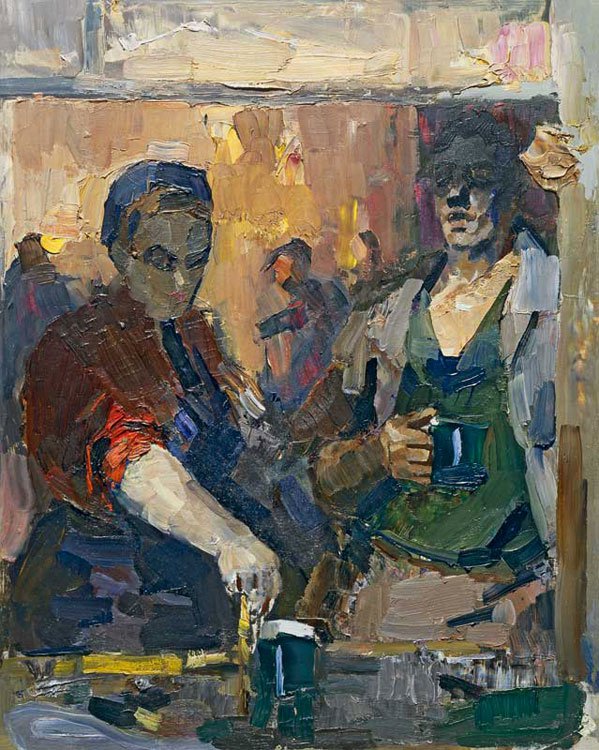 |
||
Mikhail Trufanov (1921-1988). Steel-maker.
Publications:
Sergei V. Ivanov. Unknown Socialist Realism. The Leningrad School. Saint Petersburg, NP-Print Edition, 2007, plate 158.
Provenance:
Private collection. Acquired from the artist's family.
For more details about artist Biography, Career, and Artistic Creativity, as well as Bibliography please visit Wikipedia:
https://en.wikipedia.org/wiki/Mikhail_Trufanov
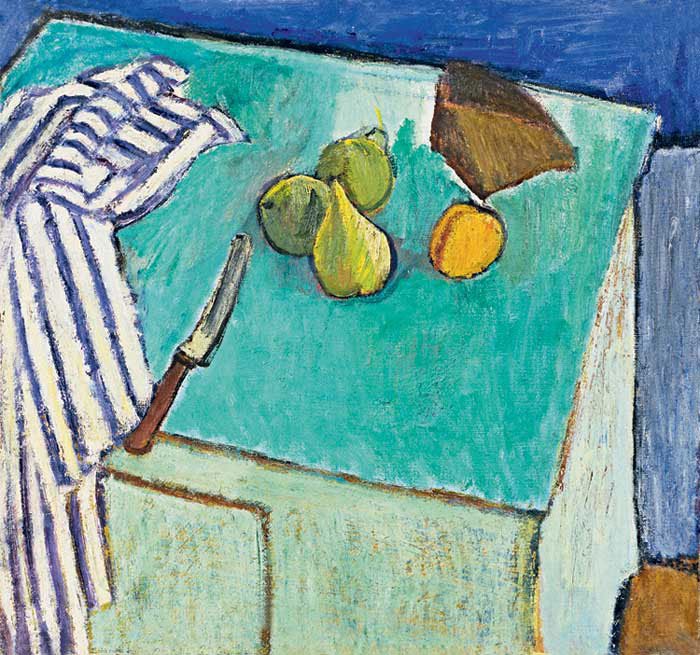 |
||
Gevork Kotiantz (1906-1996). Green still life.
Publications:
* Sergei V. Ivanov. Unknown Socialist Realism. The Leningrad School. Saint Petersburg, NP-Print Edition, 2007, plate 134.
* Котьянц Г. В. Зелёный натюрморт // 80 лет Санкт-Петербургскому Союзу художников. Юбилейная выставка. СПб : Цветпринт, 2012. С. 205.
Provenance:
Private collection. Acquired from the artist's family.
For more details about artist Biography, Career, and Artistic Creativity, as well as Bibliography please visit Wikipedia:
https://en.wikipedia.org/wiki/Gevork_Kotiantz
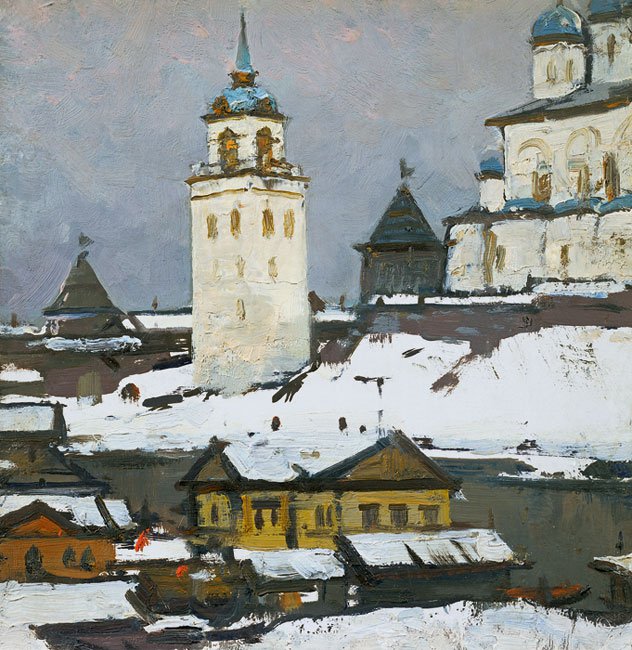 |
||
Mikhail Kaneev (1923-1983). Ancient Pskov.
Publications:
* Sergei V. Ivanov. Unknown Socialist Realism. The Leningrad School. Saint Petersburg, NP-Print Edition, 2007, plate 320.
* Этюд в творчестве ленинградских художников. Выставка произведений. Каталог. СПб, 1994. С.4.
* Лирика в произведениях художников военного поколения. Выставка произведений. Каталог. СПб, 1995. С.4.
* Живопись 1940-1990 годов. Ленинградская школа. Выставка произведений. СПб, 1996. С.3.
* Канеев М. Псков // 80 лет Санкт-Петербургскому Союзу художников. Юбилейная выставка. CПб, Цветпринт, 2012. С.205.
Provenance:
Private collection. Acquired from the artist's family.
For more details about artist Biography, Career, and Artistic Creativity, as well as Bibliography please visit Wikipedia:
https://en.wikipedia.org/wiki/Mikhail_Kaneev
 |
||
Elena Skuin (1908-1988). Wistarias.
Publications:
Sergei V. Ivanov. Unknown Socialist Realism. The Leningrad School. Saint Petersburg, NP-Print Edition, 2007, plate 97.
Provenance:
Private collection. Acquired from the artist's family.
For more details about artist Biography, Career, and Artistic Creativity, as well as Bibliography please visit Wikipedia:
https://en.wikipedia.org/wiki/Elena_Skuin
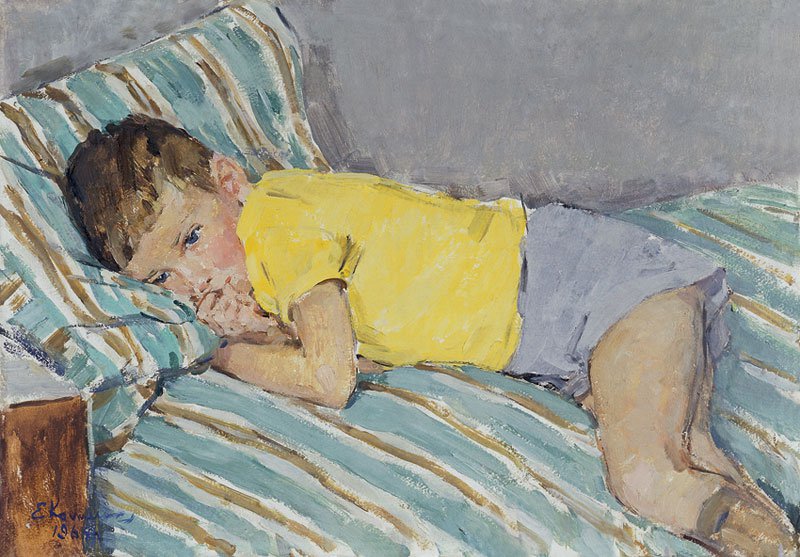 |
||
Elena Kostenko (b. 1926). Offended.
Publications:
Sergei V. Ivanov. Unknown Socialist Realism. The Leningrad School. Saint Petersburg, NP-Print Edition, 2007, plate 98.
Provenance:
Private collection. Acquired from the artist's studio.
For more details about artist Biography, Career, and Artistic Creativity, as well as Bibliography please visit Wikipedia:
https://en.wikipedia.org/wiki/Elena_Kostenko
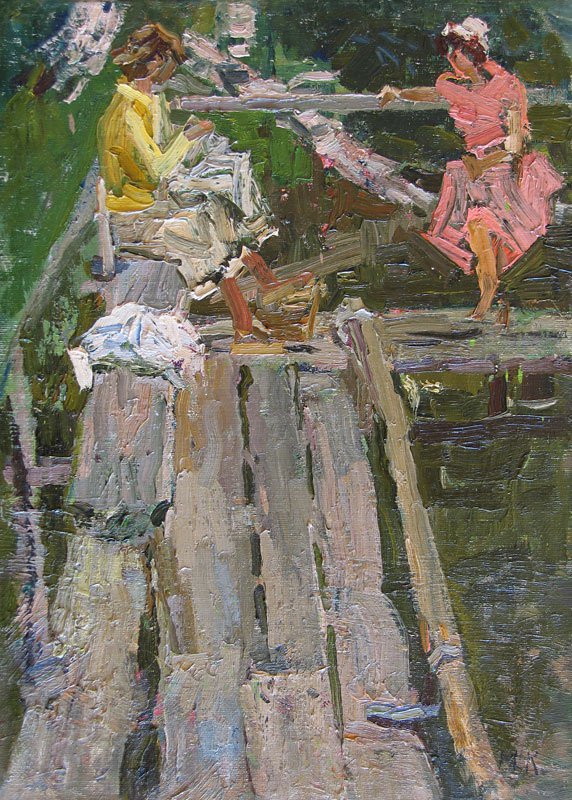 |
||
Maya Kopitseva (1924-2005). At the bathing pool.
Publications:
* Sergei V. Ivanov. Unknown Socialist Realism. The Leningrad School. Saint Petersburg, NP-Print Edition, 2007, plate 94.
* Ленинградские художники. Живопись 1950-1980 годов. Каталог. СПб, Выставочный центр СПСХ, 1994. С.3.
* Этюд в творчестве ленинградских художников. Выставка произведений. Каталог. СПб, Мемориальный музей Н. А. Некрасова, 1994. С.4.
* Живопись 1940-1990 годов. Ленинградская школа. Выставка произведений. СПб, Мемориальный музей Н. А. Некрасова, 1996. С.3.
* Левитин А. Майя Копытцева. Художник. Личность. Друг. СПб, Левша, 2010.
Provenance:
Private collection. Acquired from the artist's studio.
For more details about artist Biography, Career, and Artistic Creativity, as well as Bibliography please visit Wikipedia:
https://en.wikipedia.org/wiki/Maya_Kopitseva
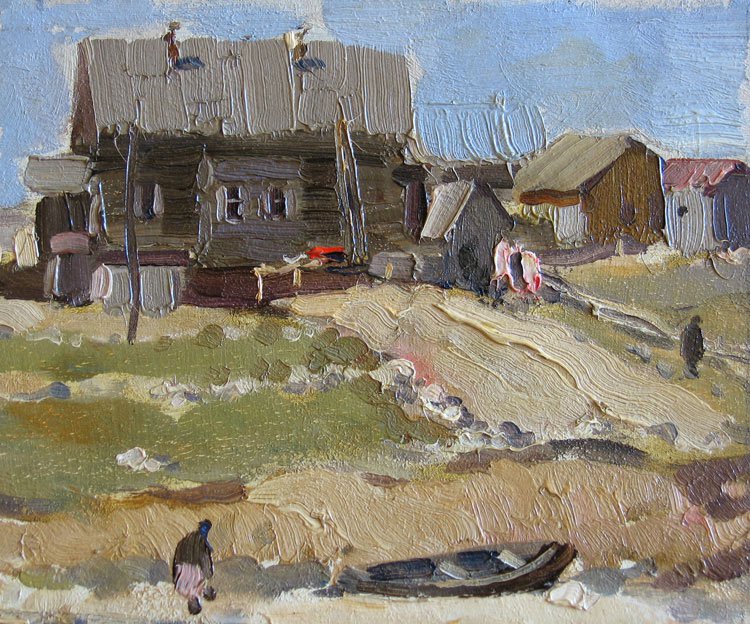 |
||
Alexei Eriomin (1919-1998). Riverside.
Publications:
* Sergei V. Ivanov. Unknown Socialist Realism. The Leningrad School. Saint Petersburg, NP-Print Edition, 2007, plate 176.
* Этюд в творчестве ленинградских художников. Выставка произведений. Каталог. СПб, Мемориальный музей Н. А. Некрасова, 1994. С.3.
* Лирика в произведениях художников военного поколения. Выставка произведений. Каталог. СПб, Мемориальный музей Н. А. Некрасова, 1995. С.3.
Provenance:
Private collection. Acquired from the artist's studio.
For more details about artist Biography, Career, and Artistic Creativity, as well as Bibliography please visit Wikipedia:
https://en.wikipedia.org/wiki/Alexei_Eriomin
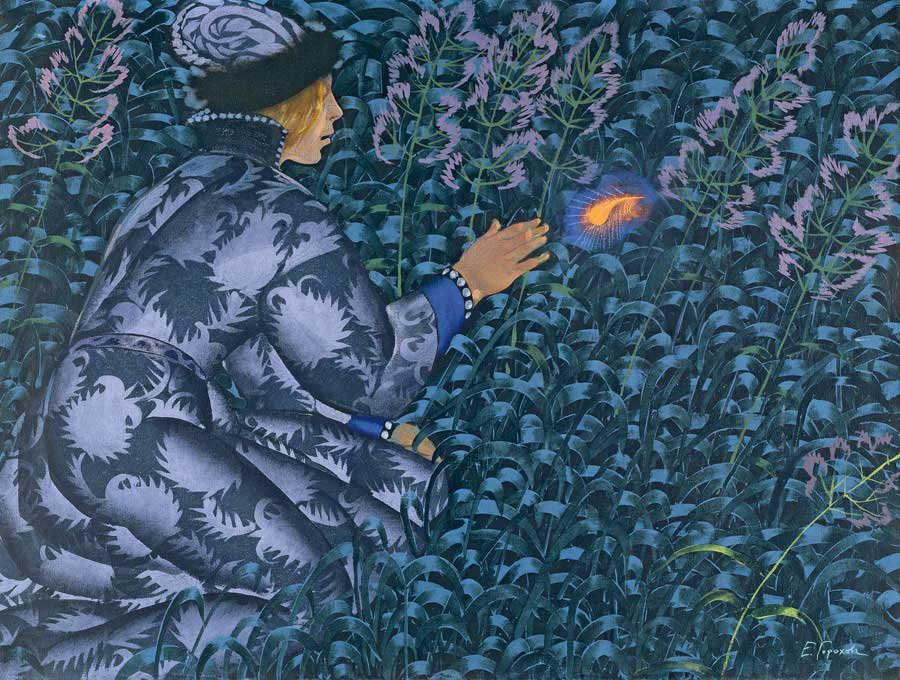 |
||
Elena Gorokhova (1933-2014). A Fire-Bird Feather.
Publications:
Sergei V. Ivanov. Unknown Socialist Realism. The Leningrad School. Saint Petersburg, NP-Print Edition, 2007, plate 74.
Provenance:
Private collection. Acquired from the artist's studio.
For more details about artist Biography, Career, and Artistic Creativity, as well as Bibliography please visit Wikipedia:
https://en.wikipedia.org/wiki/Elena_Gorokhova
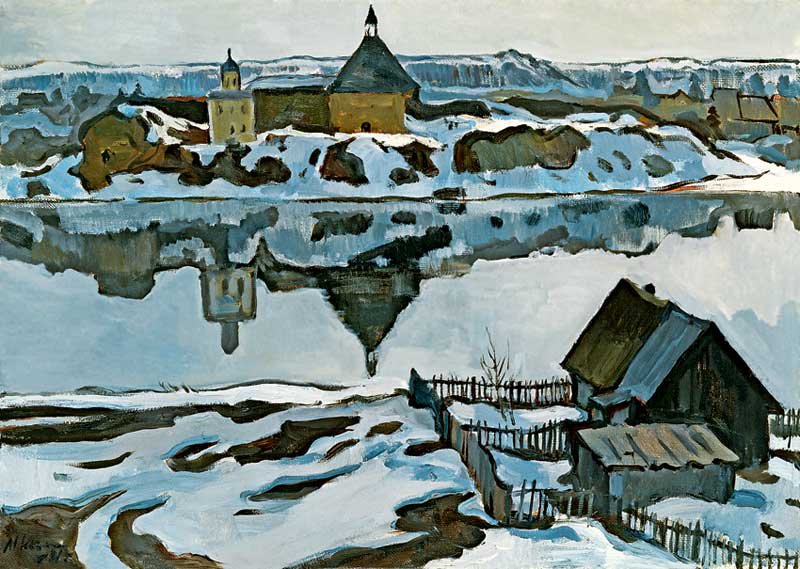 |
||
Marina Kozlovskaya (b. 1925). Fortress in Old Ladoga.
Publications:
* Sergei V. Ivanov. Unknown Socialist Realism. The Leningrad School. Saint Petersburg, NP-Print Edition, 2007, plate 114.
* Ленинградские художники. Живопись 1950-1980-х годов. Каталог. СПб, Выставочный центр СПСХ, 1994. С.3.
* Этюд в творчестве ленинградских художников. Выставка произведений. Каталог. СПб, Мемориальный музей Н. А. Некрасова, 1994. С.4.
Provenance:
Private collection. Acquired from the artist's studio.
For more details about artist Biography, Career, and Artistic Creativity, as well as Bibliography please visit Wikipedia:
https://en.wikipedia.org/wiki/Marina_Kozlovskaya
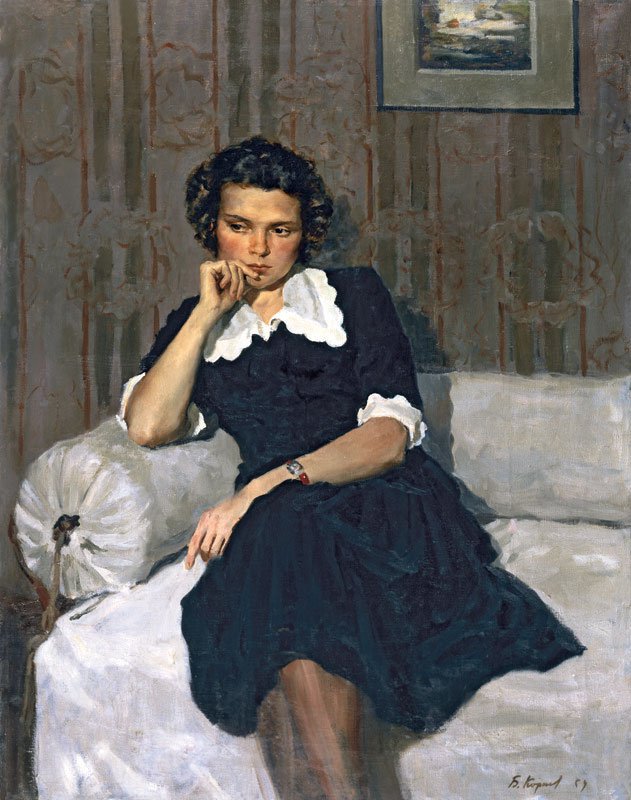 |
||
Boris Korneev (1922-1973). Portrait of artist Marina Kozlovskaya.
Publications:
* Sergei V. Ivanov. Unknown Socialist Realism. The Leningrad School. Saint Petersburg, NP-Print Edition, 2007, plate 25.
* Борис Васильевич Корнеев. Каталог выставки произведений. Л.: Художник РСФСР, 1975.
* Борис Корнеев. Живопись. Выставка произведений к 75-летию со дня рождения. Каталог. СПб, Мемориальный музей Н. А. Некрасова, 1997.
Provenance:
Private collection. Acquired from the artist's family.
For more details about artist Biography, Career, and Artistic Creativity, as well as Bibliography please visit Wikipedia:
https://en.wikipedia.org/wiki/Boris_Korneev
 |
||
Eugene Chuprun (1927-2003). Elms.
Publications:
Sergei V. Ivanov. Unknown Socialist Realism. The Leningrad School. Saint Petersburg, NP-Print Edition, 2007, plate 26.
Provenance:
Private collection. Acquired from the artist's studio.
For more details about artist Biography, Career, and Artistic Creativity, as well as Bibliography please visit Wikipedia:
https://en.wikipedia.org/wiki/Evgeny_Chuprun
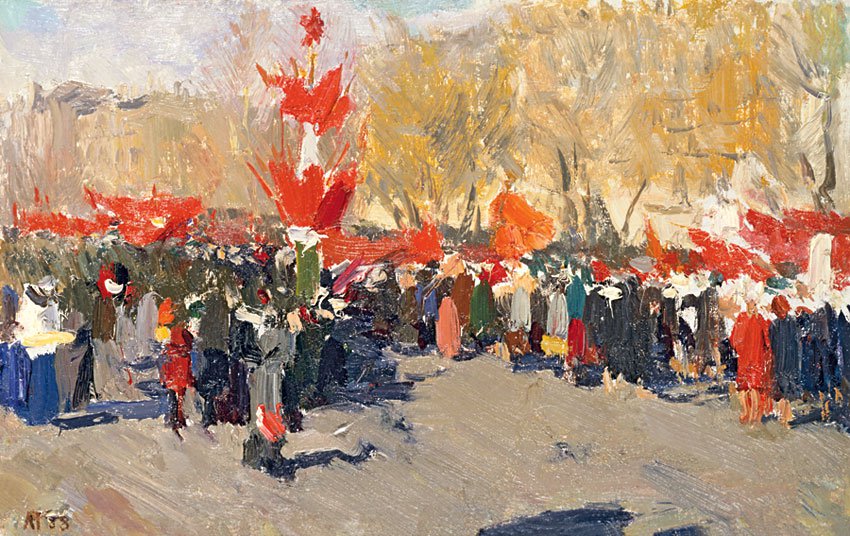 |
||
Leonid Tkachenko (b. 1927). May-Day at the Vasilievsky Island.
Publications:
* Sergei V. Ivanov. Unknown Socialist Realism. The Leningrad School. Saint Petersburg, NP-Print Edition, 2007, plate 288.
* Ленинградские художники. Живопись 1950-1980 годов. Каталог. СПб, Выставочный центр Санкт-Петербургского Союза художников, 1994. С.4.
* Этюд в творчестве ленинградских художников. Выставка произведений. Каталог. СПб, Мемориальный музей Н. А. Некрасова, 1994. С.6.
* Лирика в произведениях художников военного поколения. Выставка произведений. Каталог. СПб, Мемориальный музей Н. А. Некрасова, 1995. С.6.
* Живопись 1940-1990 годов. Ленинградская школа. Выставка произведений. СПб, Мемориальный музей Н. А. Некрасова, 1996. С.4.
Provenance:
Private collection. Acquired from the artist's studio.
For more details about artist Biography, Career, and Artistic Creativity, as well as Bibliography please visit Wikipedia:
https://en.wikipedia.org/wiki/Leonid_Tkachenko_%28artist%29
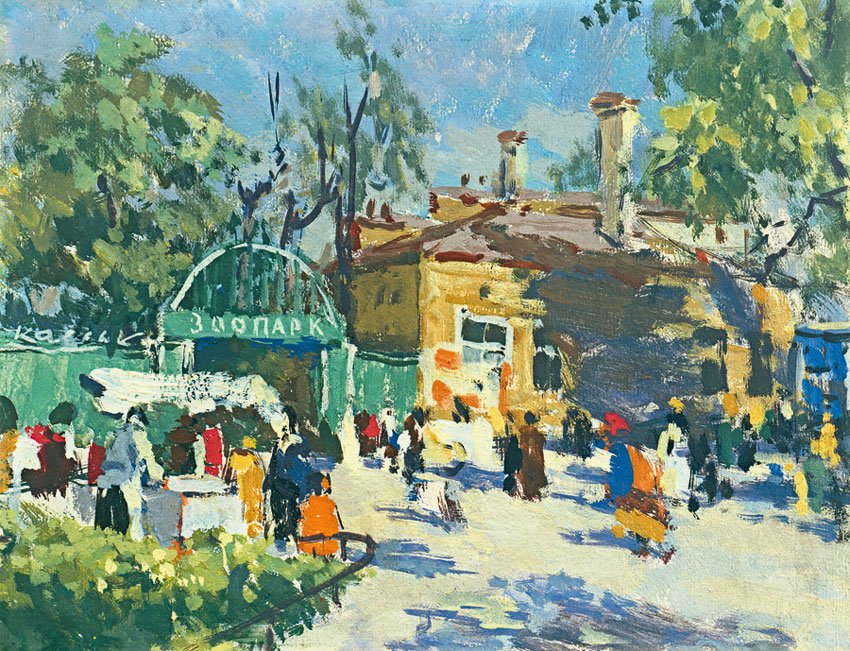 |
||
Nadezhda Shteinmiller (1915-1991). Sunny day.
Publications:
* Sergei V. Ivanov. Unknown Socialist Realism. The Leningrad School. Saint Petersburg, NP-Print Edition, 2007, plate 289.
* Ленинградские художники. Живопись 1950-1980 годов. Каталог. СПб, 1994. C.4.
* Этюд в творчестве ленинградских художников. Выставка произведений. Каталог. СПб, 1994. C.6.
* Лирика в произведениях художников военного поколения. Выставка произведений. Каталог. СПб, 1995. C.6.
* Живопись 1940-1990 годов. Ленинградская школа. Выставка произведений. СПб, 1996. C.4.
Provenance:
Private collection. Acquired from the artist's family.
For more details about artist Biography, Career, and Artistic Creativity, as well as Bibliography please visit Wikipedia:
https://en.wikipedia.org/wiki/Nadezhda_Shteinmiller
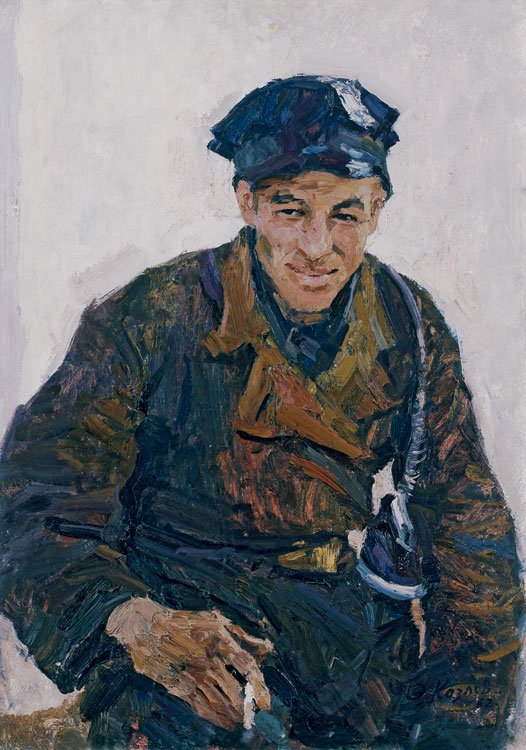 |
||
Engels Kozlov (1926-2007). Miner.
Publications:
Sergei V. Ivanov. Unknown Socialist Realism. The Leningrad School. Saint Petersburg, NP-Print Edition, 2007, plate 144.
Provenance:
Private collection. Acquired from the artist's studio.
For more details about artist Biography, Career, and Artistic Creativity, as well as Bibliography please visit Wikipedia:
https://en.wikipedia.org/wiki/Engels_Kozlov
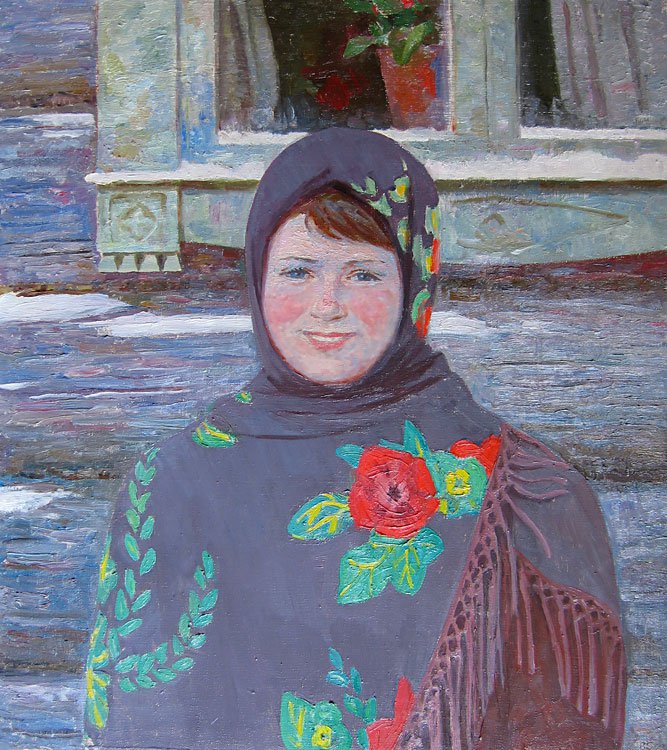 |
||
Veniamin Borisov (1935-2015). Country girl.
Provenance:
Private collection. Acquired from the artist's studio.
For more details about artist Biography, Career, and Artistic Creativity, as well as Bibliography please visit Wikipedia:
https://en.wikipedia.org/wiki/Veniamin_Borisov
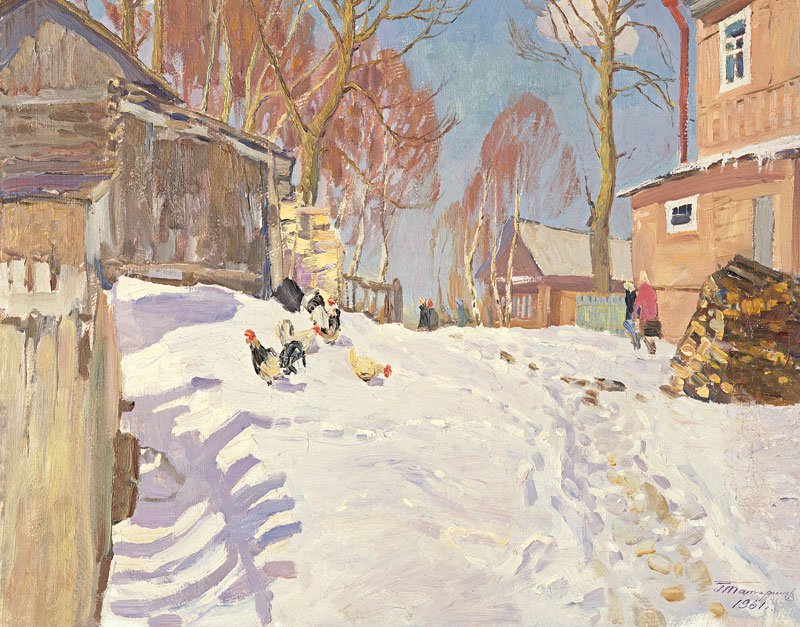 |
||
German Tatarinov (1925-2006). Spring Day in the Old Ladoga.
Publications:
Sergei V. Ivanov. Unknown Socialist Realism. The Leningrad School. Saint Petersburg, NP-Print Edition, 2007, plate 178.
Provenance:
Private collection. Acquired from the artist's studio.
For more details about artist Biography, Career, and Artistic Creativity, as well as Bibliography please visit Wikipedia:
https://en.wikipedia.org/wiki/German_Tatarinov
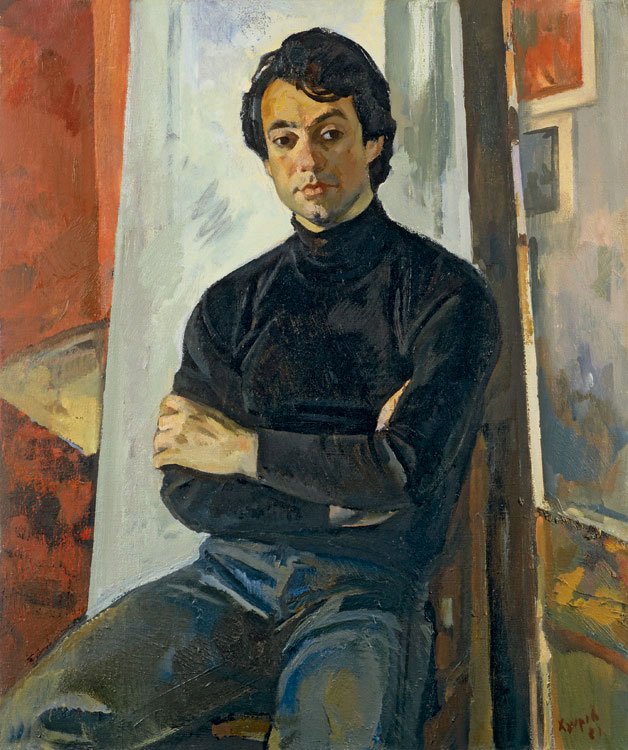 |
||
Yuri Khukhrov (1932-2003). Sergei.
Publications:
Sergei V. Ivanov. Unknown Socialist Realism. The Leningrad School. Saint Petersburg, NP-Print Edition, 2007, plate 252.
Provenance:
Private collection. Acquired from the artist's studio.
For more details about artist Biography, Career, and Artistic Creativity, as well as Bibliography please visit Wikipedia:
https://en.wikipedia.org/wiki/Yuri_Khukhrov
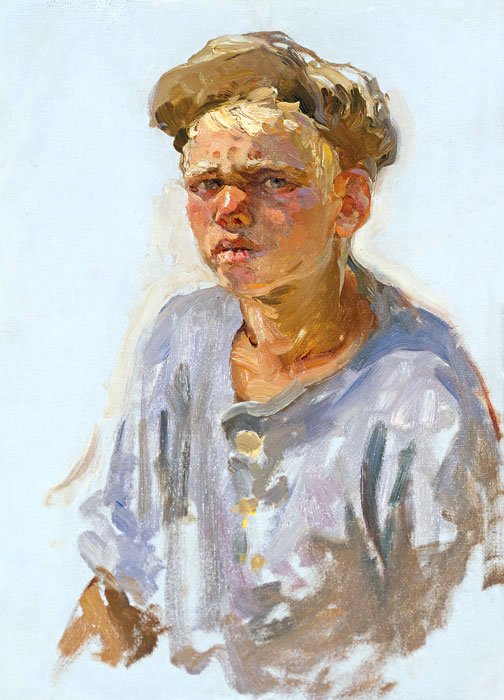 |
||
Alexander Sokolov (1918-1974). A Boy.
Publications:
Sergei V. Ivanov. Unknown Socialist Realism. The Leningrad School. Saint Petersburg, NP-Print Edition, 2007, plate 10.
Provenance:
Private collection. Acquired from the artist's family.
For more details about artist Biography, Career, and Artistic Creativity, as well as Bibliography please visit Wikipedia:
https://en.wikipedia.org/wiki/Alexander_Ivanovich_Sokolov
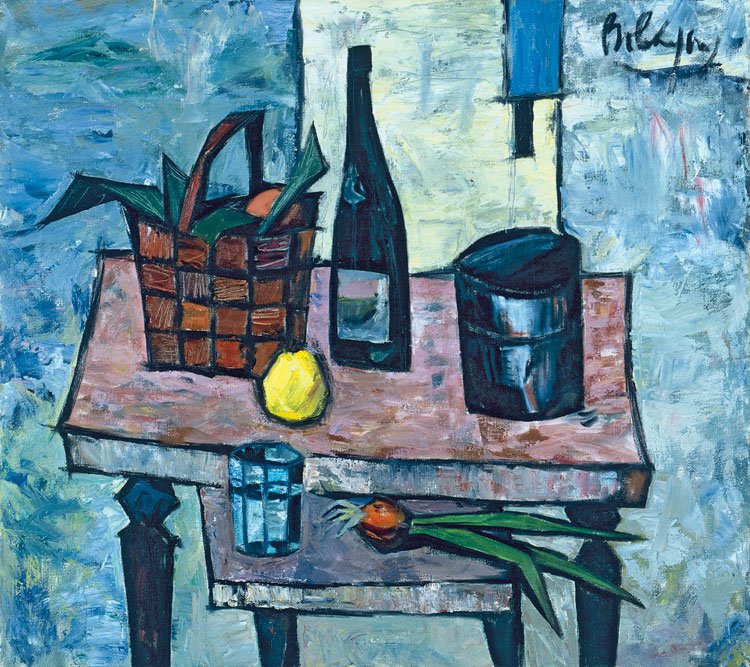 |
||
Rostislav Vovkyshevsky (1917-2000). Still Life with lemon.
Publications:
* Sergei V. Ivanov. Unknown Socialist Realism. The Leningrad School. Saint Petersburg, NP-Print Edition, 2007, plate 224.
* A Parisian from Leningrad. Rostislav Vovkushevsky. Saint Petersburg, Costa Edition, 2007.
Provenance:
Private collection. Acquired from the artist's studio.
For more details about artist Biography, Career, and Artistic Creativity, as well as Bibliography please visit Wikipedia:
https://en.wikipedia.org/wiki/Rostislav_Vovkushevsky
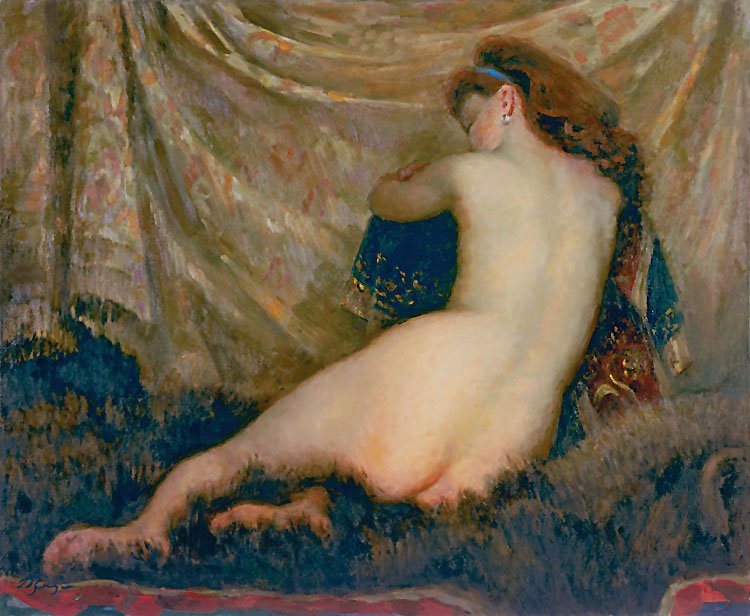 |
||
Galina Rumiantseva (1927-2004). Naked model.
Publications:
* Sergei V. Ivanov. Unknown Socialist Realism. The Leningrad School. Saint Petersburg, NP-Print Edition, 2007, plate 221.
* Ленинградские художники. Живопись 1950-1980 годов. Каталог. СПб, Выставочный центр Санкт-Петербургского Союза художников, 1994. С.5.
Provenance:
Private collection. Acquired from the artist's studio.
For more details about artist Biography, Career, and Artistic Creativity, as well as Bibliography please visit Wikipedia:
https://en.wikipedia.org/wiki/Galina_Rumiantseva
 |
||
Vladimir Chekalov (1922-1992). Junior sergeant.
Publications:
* Sergei V. Ivanov. Unknown Socialist Realism. The Leningrad School. Saint Petersburg, NP-Print Edition, 2007, plate 39.
* Ленинградские художники. Живопись 1950-1980 годов. Каталог. СПб, Выставочный центр Санкт-Петербургского Союза художников, 1994. С.4.
* Этюд в творчестве ленинградских художников. Выставка произведений. Каталог. СПб, Мемориальный музей Н. А. Некрасова, 1994. С.6.
* Лирика в произведениях художников военного поколения. Выставка произведений. Каталог. СПб, Мемориальный музей Н. А. Некрасова, 1995. С.6.
* Живопись 1940-1990 годов. Ленинградская школа. Выставка произведений. СПб, Мемориальный музей Н. А. Некрасова, 1996. С.4.
Provenance:
Private collection. Acquired from the artist's family.
For more details about artist Biography, Career, and Artistic Creativity, as well as Bibliography please visit Wikipedia:
https://en.wikipedia.org/wiki/Vladimir_Chekalov
 |
||
Irina Dobrekova (b. 1931). A Memory.
Publications:
* Sergei V. Ivanov. Unknown Socialist Realism. The Leningrad School. Saint Petersburg, NP-Print Edition, 2007, plate 109.
* Ленинградские художники. Живопись 1950-1980 годов. Каталог. СПб, Выставочный центр Санкт-Петербургского Союза художников, 1994. С.3.
* Лирика в произведениях художников военного поколения. Выставка произведений. Каталог. СПб, Мемориальный музей Н. А. Некрасова, 1995. С.3.
Provenance:
Private collection. Acquired from the artist's studio.
For more details about artist Biography, Career, and Artistic Creativity, as well as Bibliography please visit Wikipedia:
https://en.wikipedia.org/wiki/Irina_Dobrekova
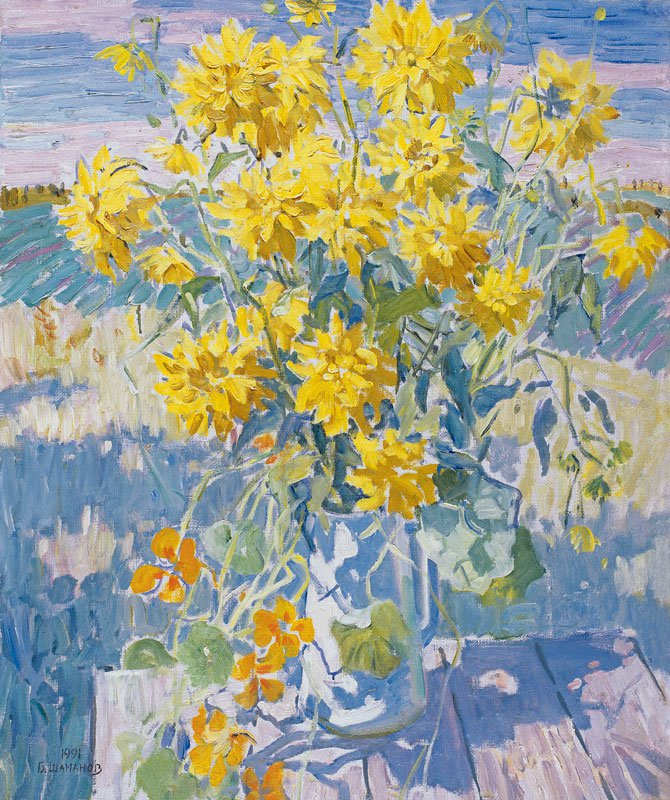 |
||
Boris Shamanov (1931-2008). September. Yellow flowers.
Publications:
Sergei V. Ivanov. Unknown Socialist Realism. The Leningrad School. Saint Petersburg, NP-Print Edition, 2007, plate 40.
Provenance:
Private collection. Acquired from the artist's studio.
For more details about artist Biography, Career, and Artistic Creativity, as well as Bibliography please visit Wikipedia:
https://en.wikipedia.org/wiki/Boris_Shamanov
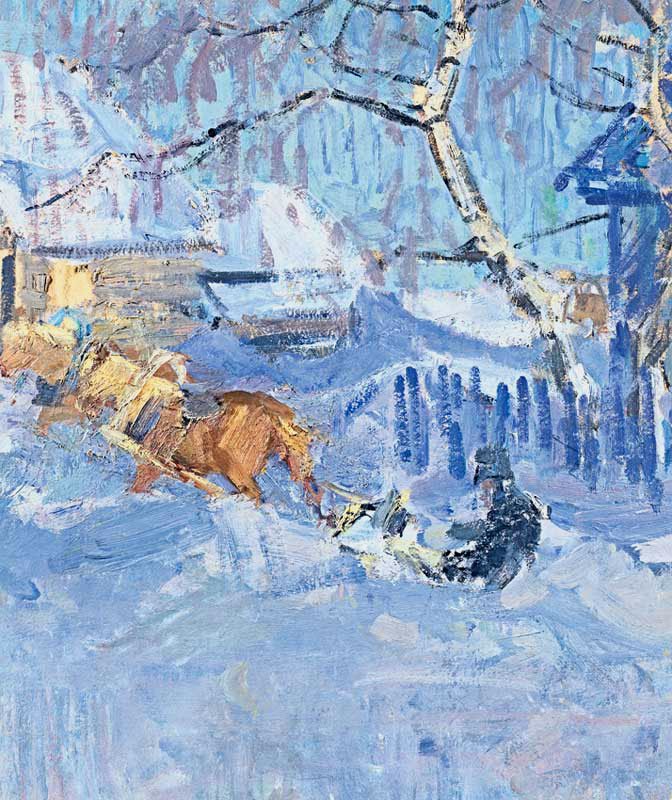 |
||
Vasily Golubev (1925-1985). Horses.
Publications:
* Sergei V. Ivanov. Unknown Socialist Realism. The Leningrad School. Saint Petersburg, NP-Print Edition, 2007, plate 46.
* Русская зима. Живопись. Выставка произведений пе6тербургских художников. Каталог. СПб, Мемориальный музей Н. А. Некрасова, 1996. С.3.
* Иванов С. В. Голубев Василий Васильевич //Страницы памяти. Справочно-биографический сборник. 1941-1945. Художники Санкт-Петербургского (Ленинградского) Союза художников — ветераны Великой Отечественной войны. Кн.1. СПб, Петрополис, 2014. С.265-266.
Provenance:
Private collection. Acquired from the artist's family.
For more details about artist Biography, Career, and Artistic Creativity, as well as Bibliography please visit Wikipedia:
https://en.wikipedia.org/wiki/Vasily_Golubev
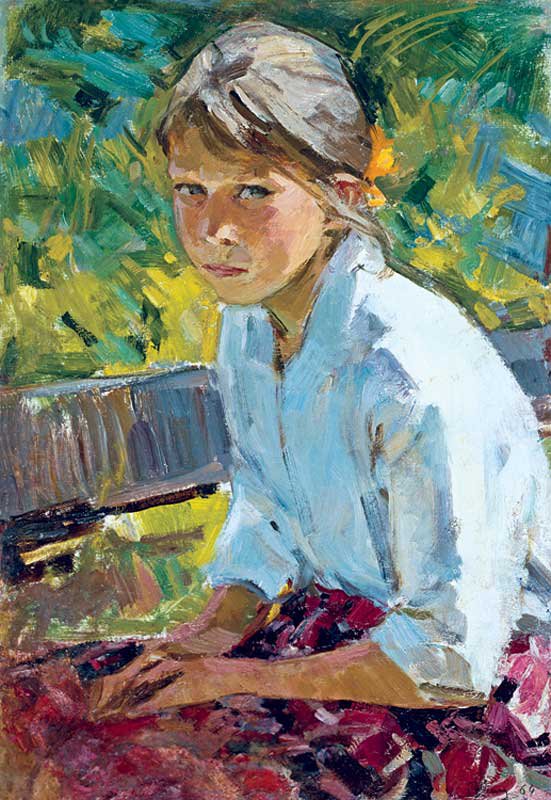 |
||
Maria Rudnitskaya (1916-1983). Girl in the Garden.
Publications:
Sergei V. Ivanov. Unknown Socialist Realism. The Leningrad School. Saint Petersburg, NP-Print Edition, 2007, plate 112.
Provenance:
Private collection. Acquired from the artist's family.
For more details about artist Biography, Career, and Artistic Creativity, as well as Bibliography please visit Wikipedia:
https://en.wikipedia.org/wiki/Maria_Rudnitskaya
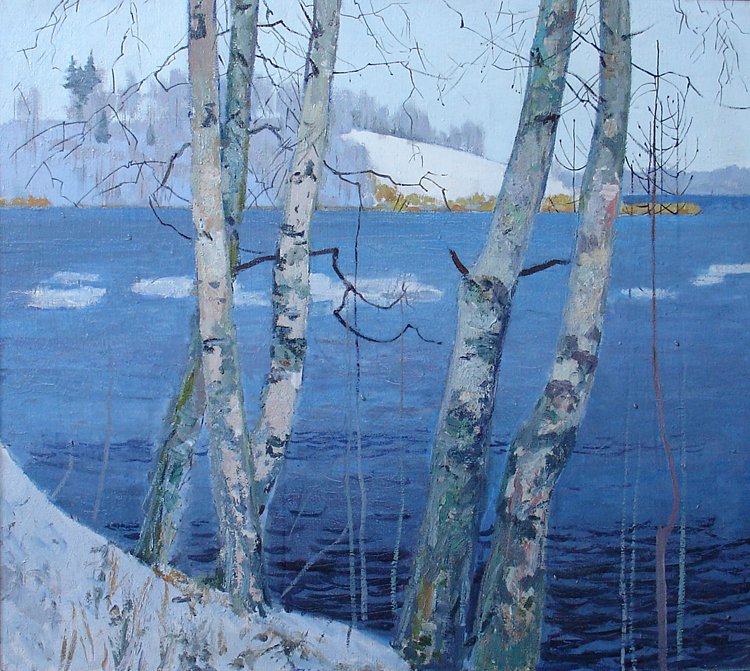 |
||
Vladimir Sakson (1927-1988). Msta River near Academicheskaya Dacha.
Provenance:
Private collection. Acquired from previous owner.
For more details about artist Biography, Career, and Artistic Creativity, as well as Bibliography please visit Wikipedia:
https://en.wikipedia.org/wiki/Vladimir_Sakson
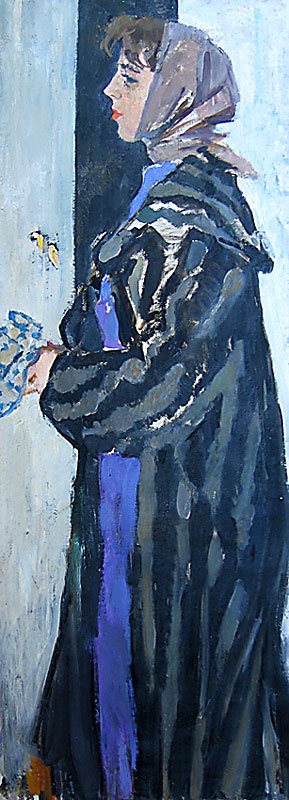 |
||
Olga Bogaevskaya (1915-2000). Portrait of Rina Soluyanova.
Provenance:
Private collection. Acquired from art dealer.
For more details about artist Biography, Career, and Artistic Creativity, as well as Bibliography please visit Wikipedia:
https://en.wikipedia.org/wiki/Olga_Bogaevskaya
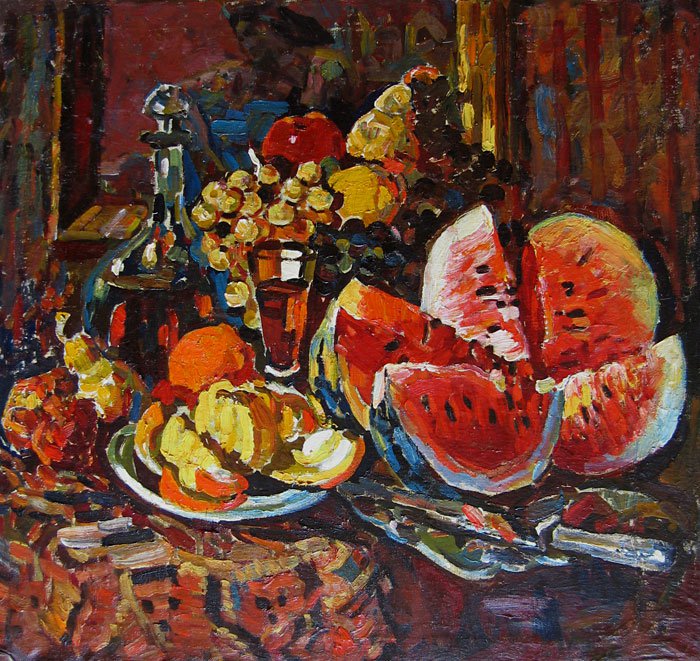 |
||
Piotr Alberti (1913-1994). Still life with water-melon.
Publications:
* Лирика в произведениях художников военного поколения. Выставка произведений. Каталог. СПб, Мемориальный музей Н. А. Некрасова, 1995. С.3.
* Натюрморт в живописи 1940-1990 годов. Ленинградская школа. Каталог выставки. СПб, 1997. С. 3.
Provenance:
Private collection. Acquired from the artist's family.
For more details about artist Biography, Career, and Artistic Creativity, as well as Bibliography please visit Wikipedia:
https://en.wikipedia.org/wiki/Piotr_Alberti
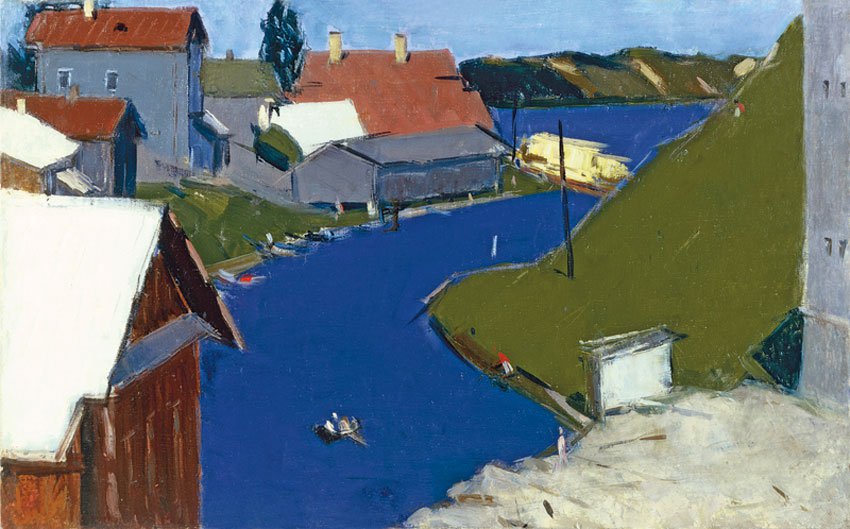 |
||
Arseny Semionov (1911-1992). Old Ladoga Town.
Publications:
Sergei V. Ivanov. Unknown Socialist Realism. The Leningrad School. Saint Petersburg, NP-Print Edition, 2007, plate 125.
Provenance:
Private collection. Acquired from the artist's family.
For more details about artist Biography, Career, and Artistic Creativity, as well as Bibliography please visit Wikipedia:
https://en.wikipedia.org/wiki/Arseny_Semionov
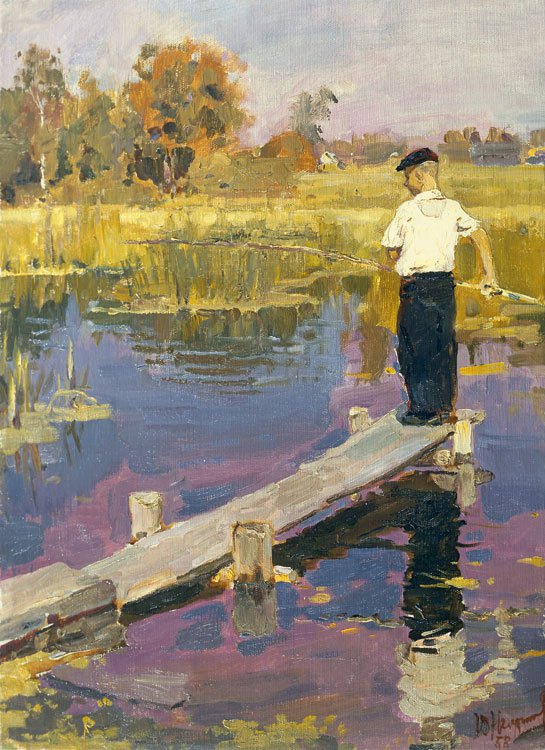 |
||
Yuri Neprintsev (1909-1996). Angler.
Publications:
Sergei V. Ivanov. Unknown Socialist Realism. The Leningrad School. Saint Petersburg, NP-Print Edition, 2007, plate 108.
Provenance:
Private collection. Acquired from the artist's studio.
For more details about artist Biography, Career, and Artistic Creativity, as well as Bibliography please visit Wikipedia:
https://en.wikipedia.org/wiki/Yuri_Neprintsev
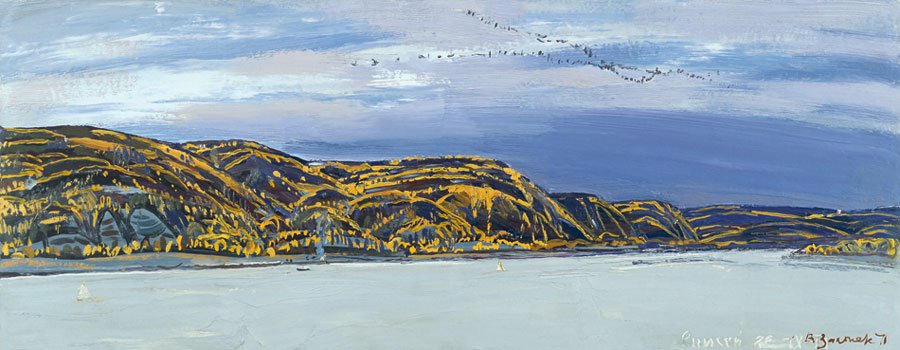 |
||
Vecheslav Zagonek (1919-1994). Yenisey River.
Publications:
* Вячеслав Францевич Загонек. Каталог. Л: Музей Академии художеств СССР, 1990.
* Sergei V. Ivanov. Unknown Socialist Realism. The Leningrad School. Saint Petersburg, NP-Print Edition, 2007, plate 187.
Provenance:
Private collection. Acquired from previouse owner.
For more details about artist Biography, Career, and Artistic Creativity, as well as Bibliography please visit Wikipedia:
https://en.wikipedia.org/wiki/Vecheslav_Zagonek
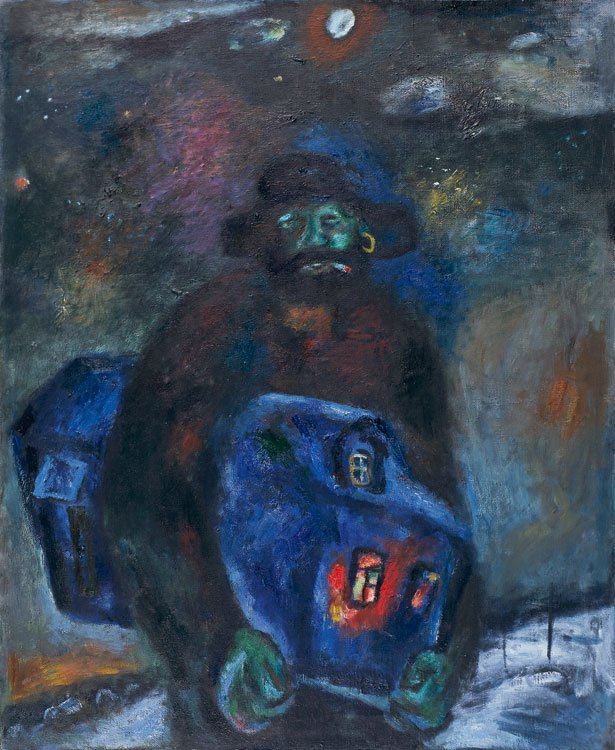 |
||
Vitaly Tulenev (1937-1998). A Midnight.
Publications:
Sergei V. Ivanov. Unknown Socialist Realism. The Leningrad School. Saint Petersburg, NP-Print Edition, 2007, plate 255.
Provenance:
Private collection. Acquired from the artist's family.
For more details about artist Biography, Career, and Artistic Creativity, as well as Bibliography please visit Wikipedia:
https://en.wikipedia.org/wiki/Vitaly_Tulenev















